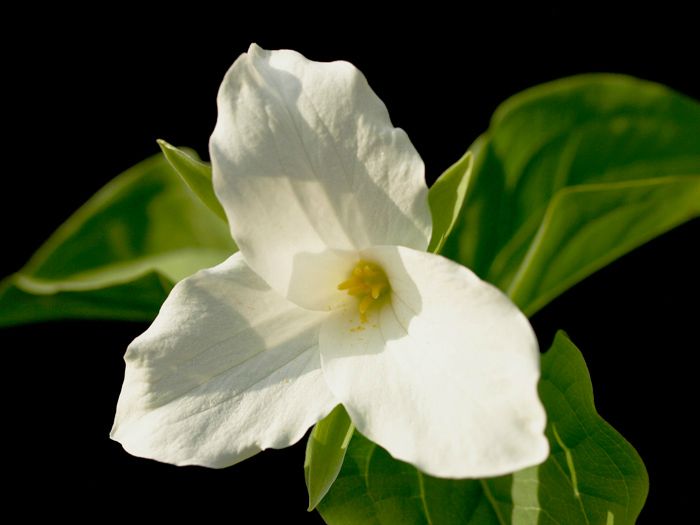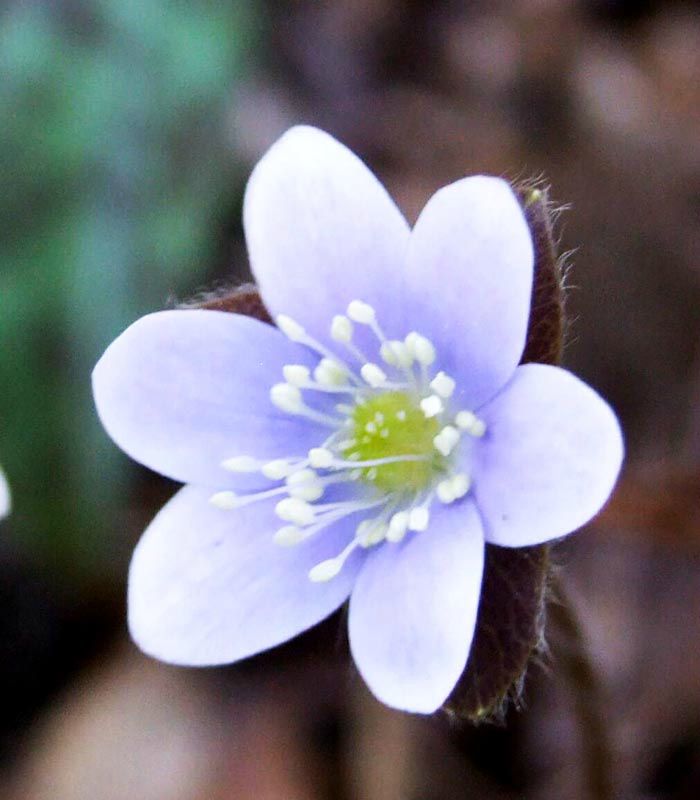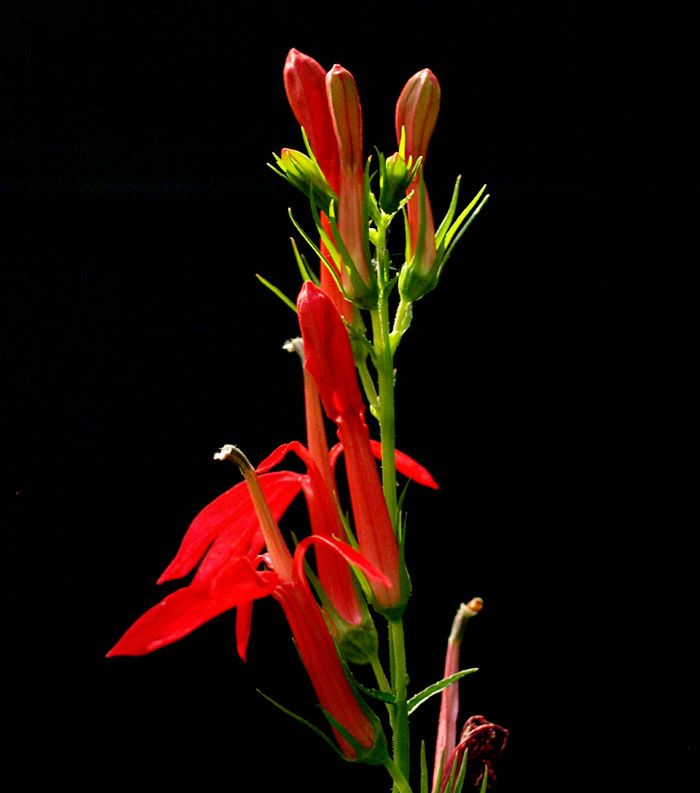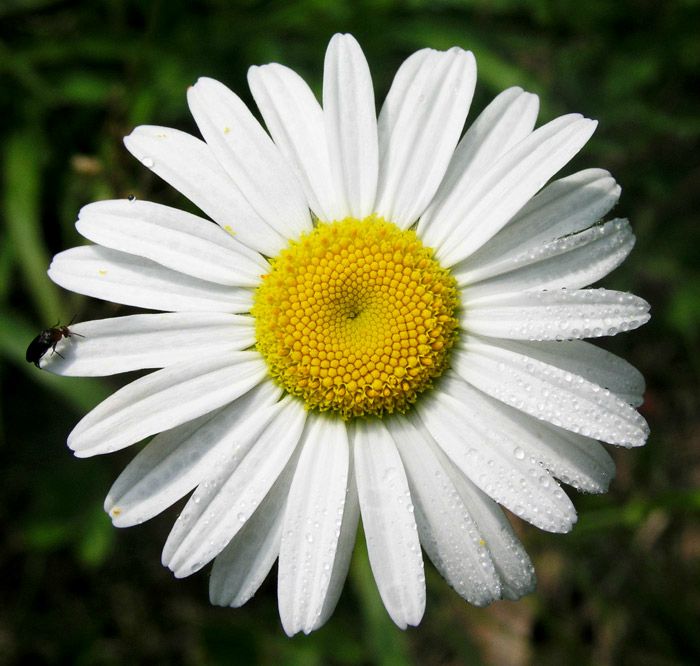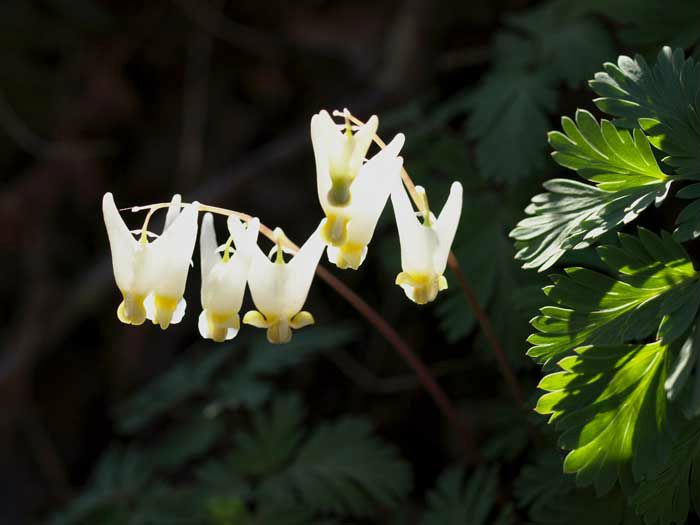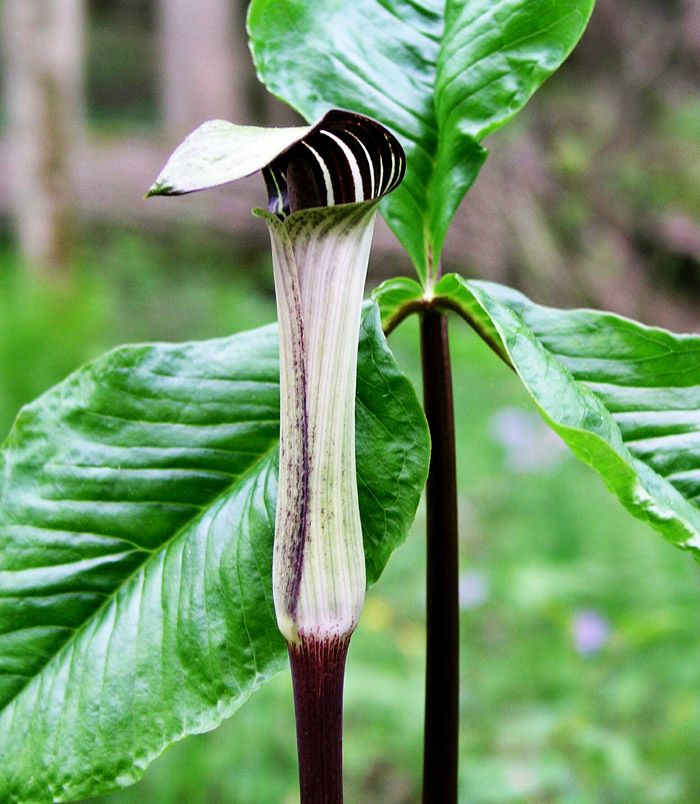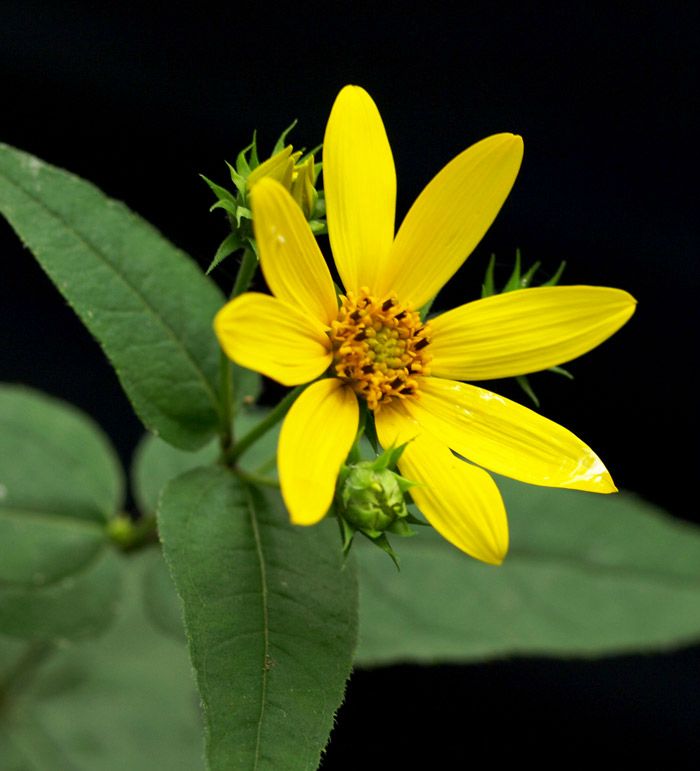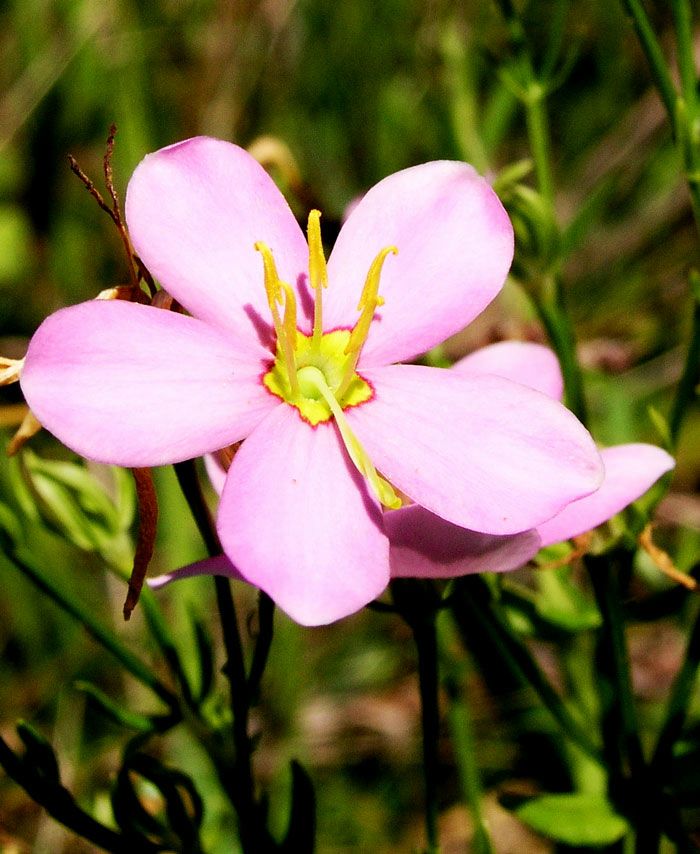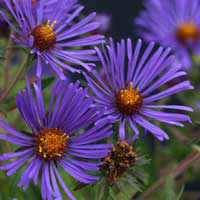
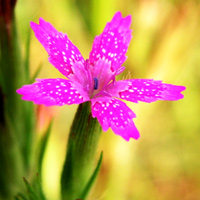
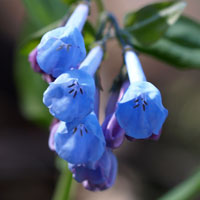
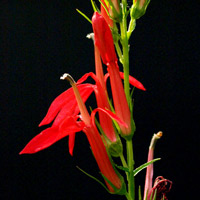
saltboiler
times
A Journal of Jackson, Ohio, for Wildflowers, Local History, and Travel
wildflowers of
jackson‚ ohio
Flower Finder —Use Drop down Menus
- First Word
Common Name - Key Word
Common Name - Color
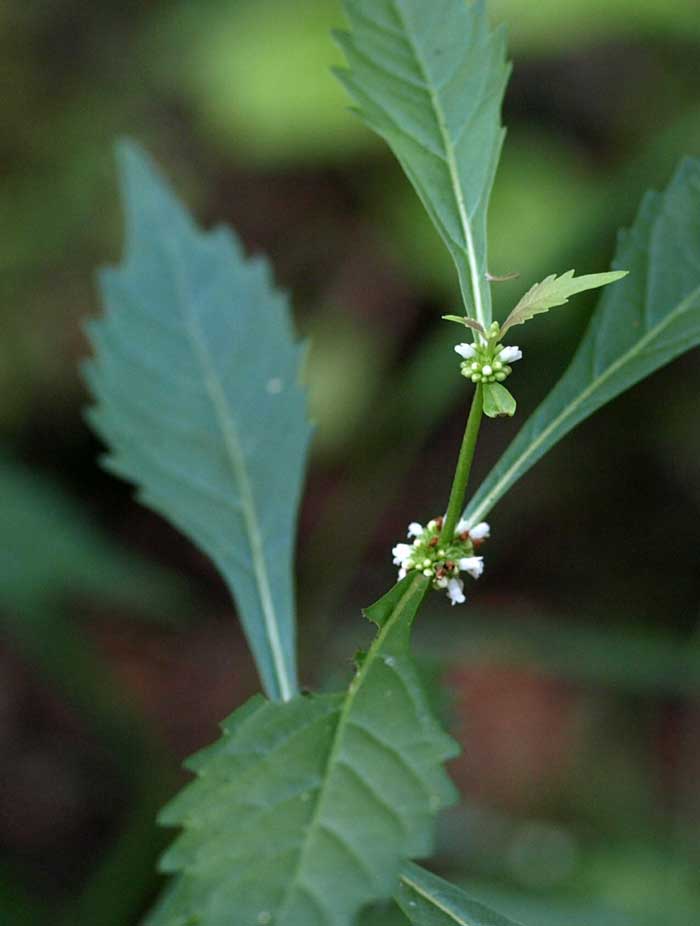
Lycopus americanus
Mint Family
Also American Bugleweed. American Water–horehound grows along wet creekbanks. It has tiny blossoms which spring from the axil of the leaf‚ which is quite unusual. Axil means the angle between the upper side of a leaf or stem and the supporting stem or branch. This plant is considered a non–aromatic mint.
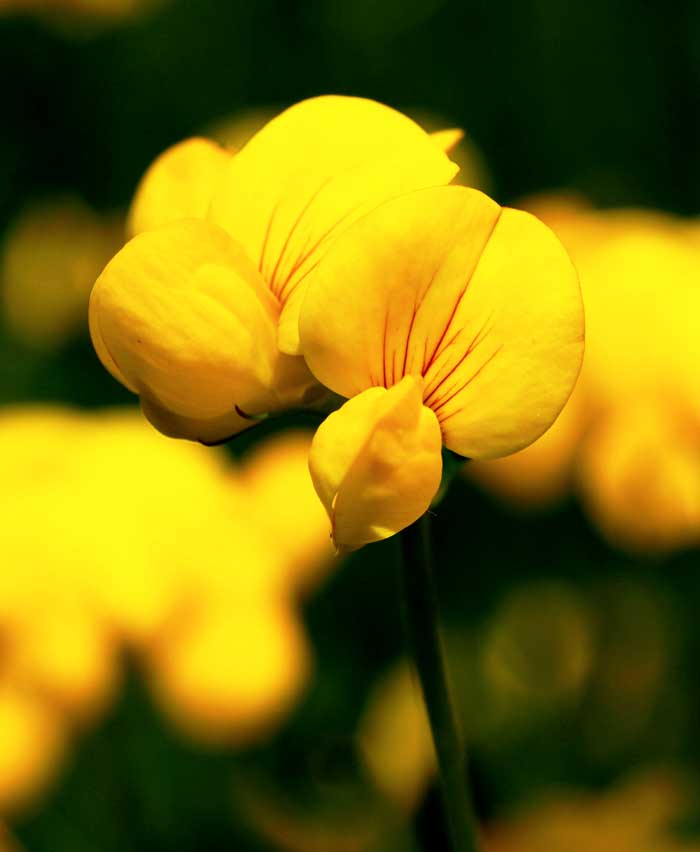
Lotus corniculatus
Legume Family
Bird’s–foot–trefoil is an introduced alien species‚ and is considered a pest. Apparently you cannot get rid of it with prescribed burning because that just makes it reproduce better. Cattle will eat it and it is sometimes used as silage‚ so it is not completely useless.
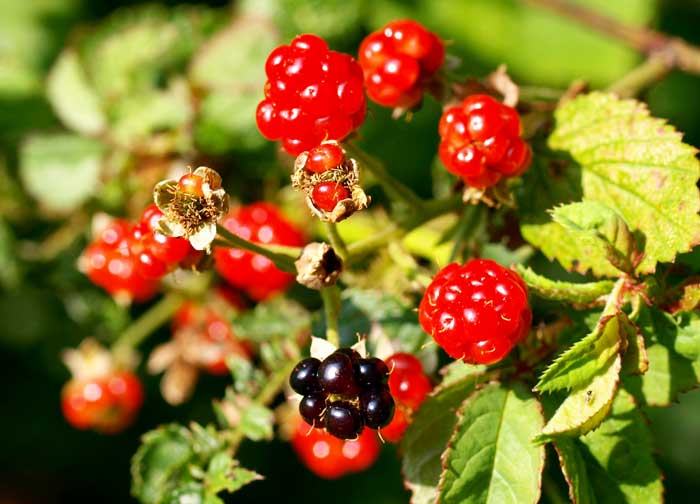
Rubus allegheniensis
Rose Family
Plants of this genus are called “brambles”‚ and include raspberries‚ dewberries‚ and blackberries. One standard reference work lists over two hundred species of brambles. These species interbreed promiscuously‚ and so hybridize. As a result the taxonomy of blackberries is uncertain.
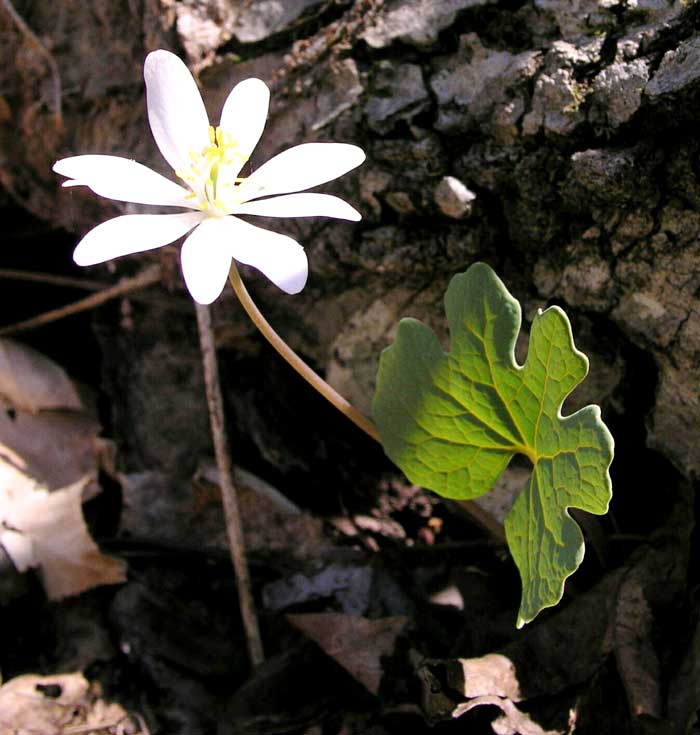
Sanguinaria canadensis
Poppy Family
At Lake Katharine‚ Bloodroot flowers are one of the harbingers of spring. Small bees and flies cross–pollinate the flowers by transporting pollen from one flower to another. Bloodroot produces seeds with oil–rich outgrowths called elaiosomes‚ which are a favorite food of ants. Ants carry the seed to their nest‚ eat the elaiosome‚ and discard the seed out of the nesting site. This disperses the seeds. Bloodroot blossoms last only a day or two before a breeze blows away the petals. Bloodroot‚ as the name suggests‚ contains a reddish sap in its rhizome. Native Americans used the red sap as dye and body paint. This flower is in the poppy family‚ and its sap contains several chemical compounds which may have antimicrobial‚ anticancer‚ and antifungal effects.
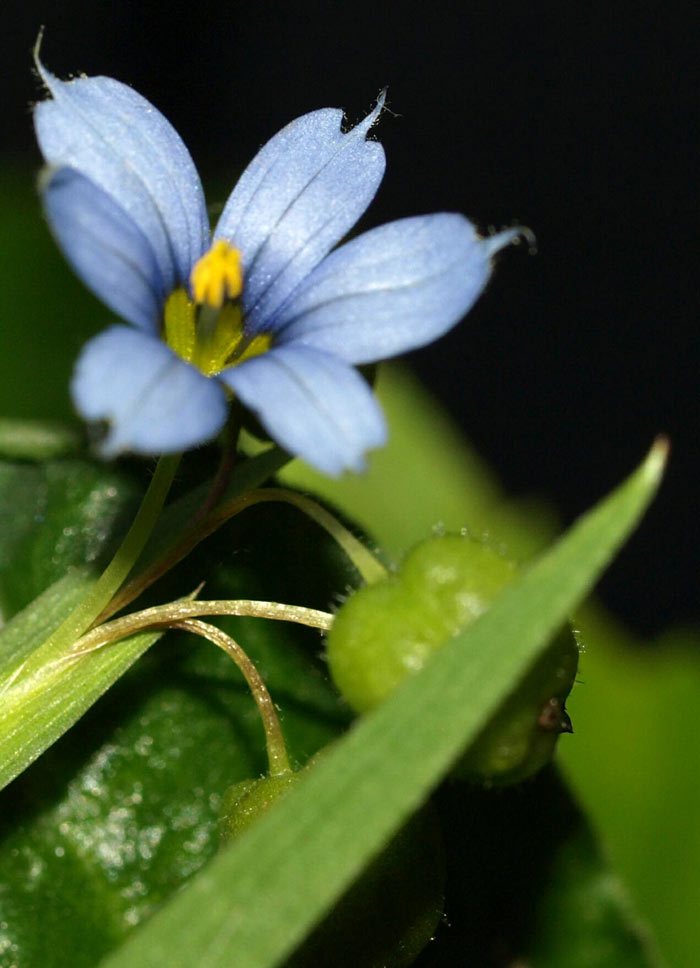
Sisyrinchium
angustifolium
Iris Family
Also Narrow–leaved Blue–eyed Grass. This is a native perennial. It is not a true grass‚ but looks like grass because of the narrow leaves. The stem is winged‚ and the wing structures stiffen the stem. The flower grows from a vertical stem arising from a horizontal underground stem‚ or rhizome. Note the round seed pod in the photograph.
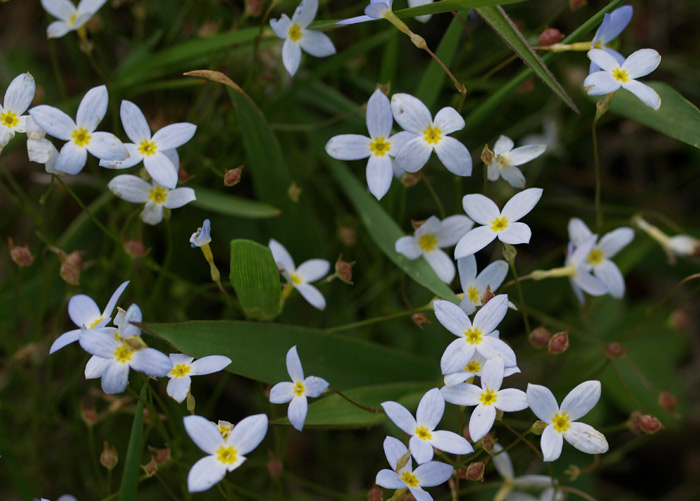
Houstonia caerulea
Madder Family
Also Quaker Ladies or Innocence. These small flowers often grow profusely in large colonies. Some of the blossoms have long stamens and a short style‚ and others have short stamens and a long style. One supposes this arrangement encourages cross–pollination.
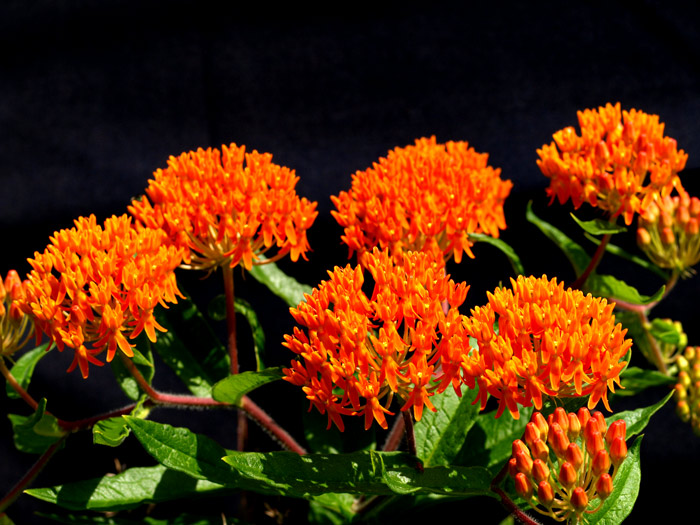
Asclepias tuberosa
Milkweed Family
These milkweed flowers seem particularly attractive to butterflies‚ of course. People find them strikingly beautiful‚ too. They are found in open fields with lots of sun. Early Native Americans found many uses for Butterfly Weed. Mound Builders in Ohio used the stalks to extract fibers to make cloth‚ rope‚ and string. Mounds dating from 700 B.C. to A.D. 1000 were found to contain Butterfly Weed textiles. Native Americans also used the plant root for a variety of medicinal purposes. Nineteenth century American physicians used it as an expectorant and to treat smallpox.
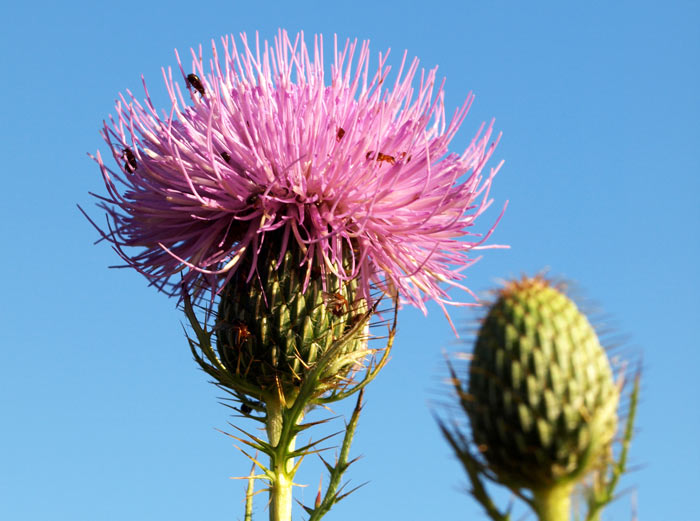
Cirsium arvense
Aster Family
Canada Thistle is difficult to distinguish from the closely related Bull Thistle‚ C. vulgare and Field Thistle, C. discolor. Thistles can propagate asexually by spreading roots horizontally‚ with new shoots for flowers. If the flowers do manage to achieve sexual reproduction‚ thistles can become profuse‚ to the dismay of the landowner.
I always wondered how a thistle could become the national flower and virtual symbol of Scotland. The Scotch Thistle is a different genus and species from Canada Thistle‚ but they are all thorny. According to Jack Sanders [see Acknowledgements‚ below]‚ the legend starts with Norsemen (Vikings) invading Scotland and the native Celts. One night Norse soldiers sneaked up on a Scottish camp barefoot‚ to minimize noise. One invader unwittingly stepped on a thistle and yelped. This aroused the sleeping Scots‚ who awoke and‚ as is their wont‚ slaughtered the Norsemen. So the Scottish Thistle saved the nation on that particular occasion. In Ohio‚ thistles do well feeding goldfinches.
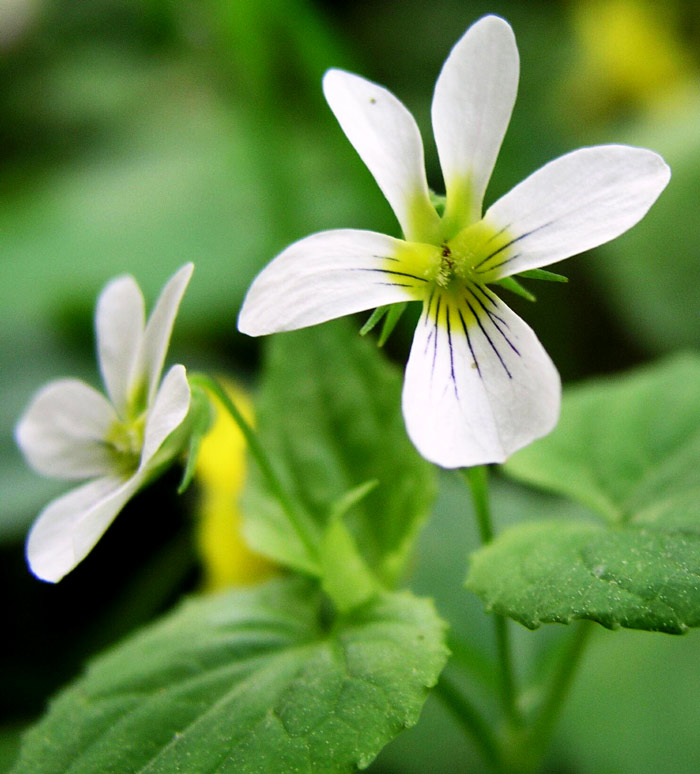
Viola canadensis
Violet Family
The identification here is uncertain because the Canada Violet is similar to the Striped White Violet‚ Viola striata. The Canada violet blossom rests upon a vertical stem which arises from an underground rhizome. This rhizome stores nutrients for the flower to use during the energy–intensive activities of sexual reproduction. This photograph clearly shows the “landing lights” lines on the petals for visiting insects. The fruits of this flower split open to release their seeds‚ and propel the seeds outward as much as five meters. The seed also has an elaiosome‚ which is an oil–rich tissue attached to its outside. Ants carry away the seed‚ eat the elaiosome‚ and discard the still–intact seed. Compare this to eating an apple and tossing away the core. Thus violets have the benefit of two different kinds of seed dispersal.
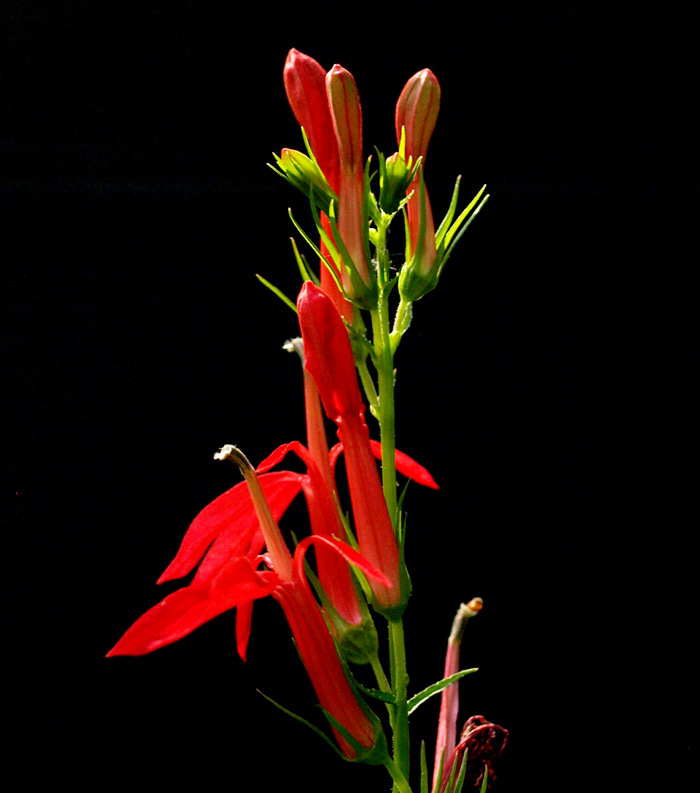
Lobelia cardinalis
Bellflower Family
These strikingly beautiful flowers grow near streams and wetlands. Roger Tory Peterson called the Cardinal Flower “America’s Favorite”. Cardinal Flower used to be considered uncommon in southern Ohio‚ but recently they seem more plentiful. Still‚ please do not pick them; admire them in place. Cardinal Flowers and Ruby–throated Hummingbirds have a mutually beneficial relationship. Hunmmingbirds prefer red blossoms‚ and the Cardinal Flower blossom is well–suited for hummingbirds. The ranges of Cardinal Flowers and Ruby–throated Hummingbirds are similar. When Cardinal Flowers become scarce‚ so do the hummingbirds.
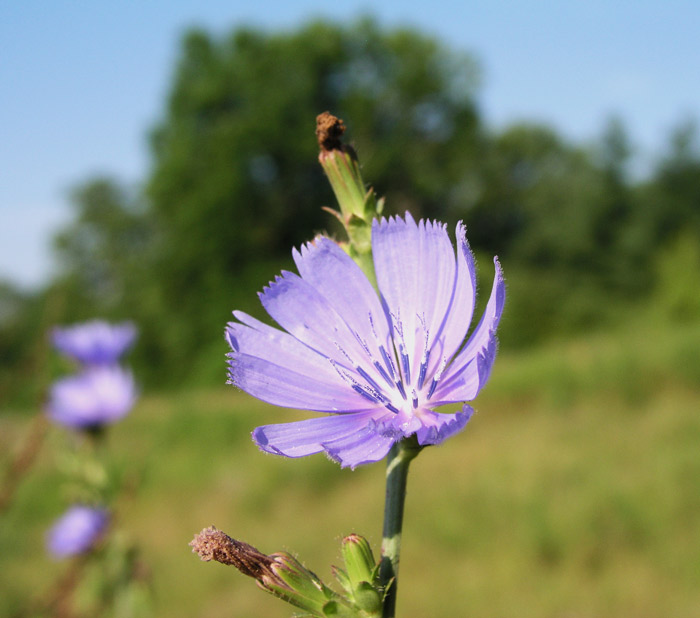
Cichorium intybus
Aster Family
The root of this flower has been roasted‚ ground‚ and used as a coffee substitute. An immigrant from Europe‚ Chicory is found along roadsides and is considered a pest. Apparently not always so. According to Jack Sanders [see Acknowledgements‚ below]‚ Thomas Jefferson wrote in 1795 to George Washington that Chicory is “one of the greatest acquisitions a farmer can have” to feed cattle. Jefferson also found Chicory made a “tolerable salead”. The Swedish botanist Linneaus gardened with Chicory‚ and noted that the blossoms opened regularly at 5:00 a.m. and closed at 10:00 a.m. The schedule is later in the U.S.‚ but the flowers do close up early on sunny days.
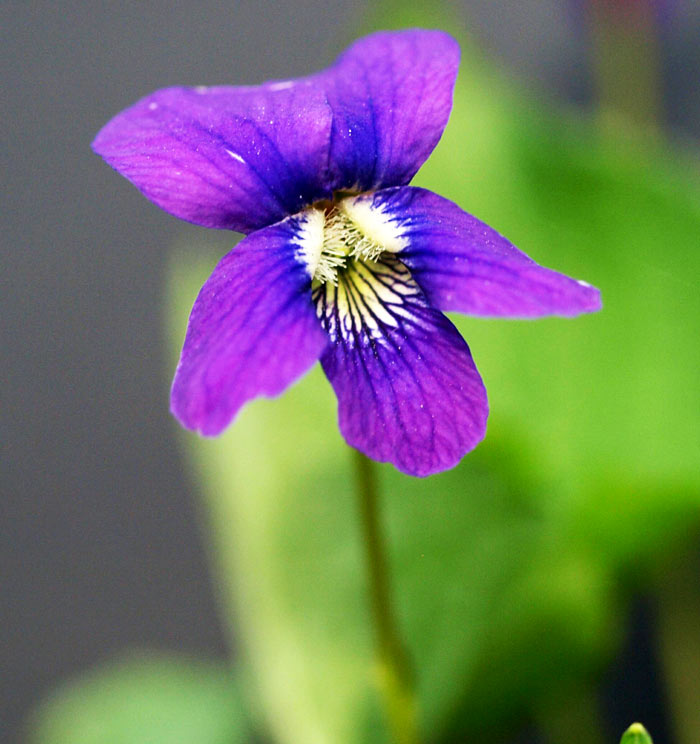
Viola sororia
Violet Family
Four species of violets are commonly found at Lake Katharine‚ namely Common Blue Violet‚ Canada Violet‚ Yellow Violet‚ and Spurred Violet. I never thought the blue violet was blue; instead it is a shade of purple. These violets are symmetrical‚ with two upper petals‚ two lateral petals‚ and one lower petal. The lower petal serves as a landing platform for pollinating insects. The lines on the petals direct insects to the spur of the flower‚ where nectar awaits. Sort of like landing lights on an airfield. The anatomy of the flower dusts pollen onto the insect as it goes after the nectar. Then with a little bit of luck the insect cross–pollinates the next violet it visits for nectar. Note also the hairs at the entry to the spur. Like our eyelashes‚ the hairs prevent raindrops from entering the spur and diluting the nectar. They also provide legholds to assist insects to enter the inner sanctum.
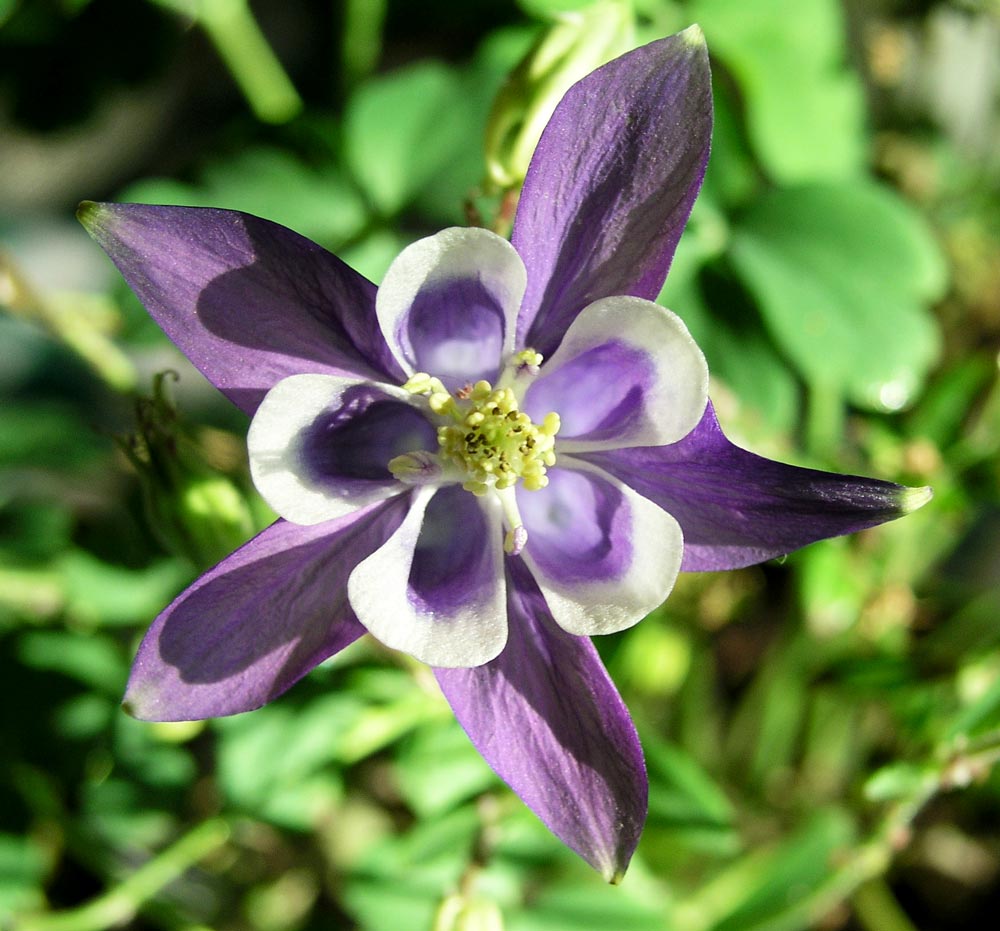
Iris cristata
Iris Family
The Crested Dwarf Iris grows in acidic soil in shady woods with some sunlight. It is common at Lake Katharine in the spring. It grows from a rhizome‚ or underground stem. The flower reportly grows in large colonies under good conditions‚ but at Lake Katharine the Crested Dwarf Iris is usually found as an individual plant. The Swedish botanist Linnaeus named the Iris family after a Greek goddess associated with rainbows.
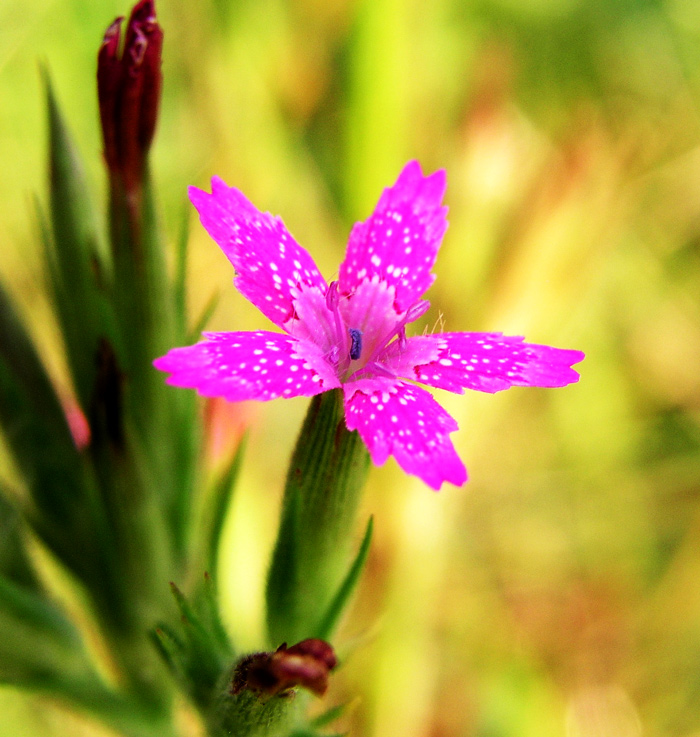
Dianthus ameria
Pink Family
The common name refers to a suburb of London‚ England‚ called Deptford. The flower was introduced here from Europe. This particular speciman was found on the earthen dam lakeside at Lake Katharine‚ in a sunny unforested place. The genus name means “divine flower”‚ from dios, “god”‚ and anthos, “flower”.
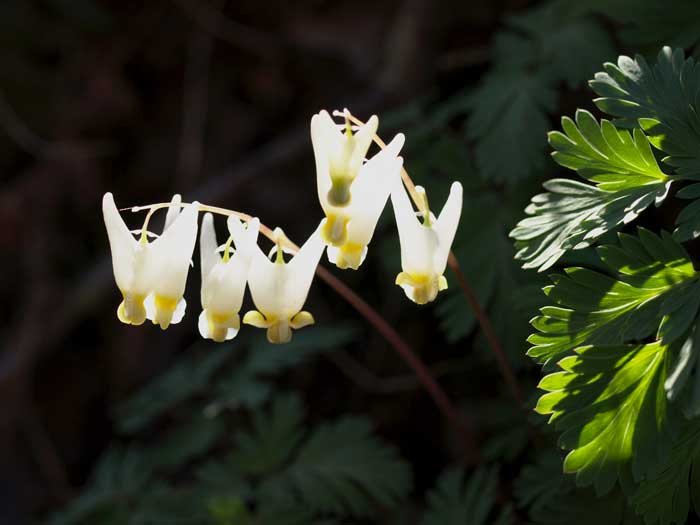
Dicentra cucullaria
Fumitory Family
This distinctive flower is profuse in Lake Katharine’s woods in the springtime. Well–named flower‚ isn’t it? The blossom has four modified petals. Two petals become spurs‚ or the legs of the pantaloons‚ with yellow coloring at the pantaloon waist. The other two petals are also yellow‚ found within the pantaloons. The inner petals form a cover for the generative stamens and pistil. The flower secretes nectar which is found in the tips of the spurs. Insects tred over or brush into pollen while going for the nectar‚ and then spread the pollen to the next flower it visits. Bumblebees are the most successful pollinators because they have tongues long enough to reach the nectar at the tip of the spur‚ and so are intensely attracted to the flower. The seeds of Dutchman’s Breeches have food bodies called elaiosomes attached to them. Ants will carry seeds back to their nests‚ eat the elaisomes‚ discard the still–intact seeds‚ and thereby disperse the seeds. This form of seed dispersal by ants is called myrmecochory.
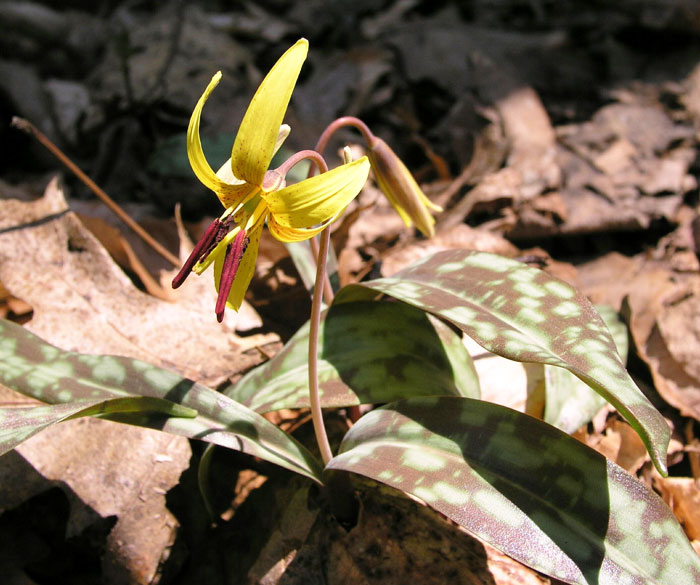
Erythronium americanum
Lily Family
Also known as Trout–lily. The common names refer to the mottled pattern of the leaf. This plant has lots of action underground. Each stem arises from a bulblet which stores starches. The bulblet also produces a stolon‚ or horizontal stem. This stolon grows outward‚ sometimes breaking above the ground surface. At intervals the stolon forms a new bulblet‚ from which will arise a vertical stem. Most of the vertical stems produce non–flowering plants. A patch of genetically identical plants results.
The blossoms of Fawn Lily droop‚ or nod‚ so that animals seeking pollen or nectar must either hover (see Wild Columbine) or hang onto the flower parts upside–down. The pedicel of the Fawn Lily is sturdy enough that pollinators can alight and crawl around the flower parts. Some of the anthers release pollen on one day‚ and the rest release the next day. This assures that insects do not cart away all of the available pollen on one visit. After all‚ honeybees take pollen for food‚ and can pack the pollen away into storage sacs‚ inaccessible for cross–pollination at the next flower. Bumblebees in particular seek out Fawn Lily pollen to feed their larva back in their nests.
Fawn Lily seeds have nutritious elaiosomes attached‚ so ants and other insects carry seeds away and eat the elaiosomes‚ leaving the rest of the seed intact. This myrmecochory effectively disperses the seed away from the clone patch. For some unknown reason Fawn Lily leaves preferentially absorb the mineral phosphorus from spring runoff water. When the leaves deteriorate after spring‚ the phosphorus returns to the soil in a form readily usable by other plants in the vicinity. Fawn Lily is thus a good neighbor.

Silene virginica
Pink Family
Also known as Catchfly. At Lake Katharine thoughtless trail walkers pick them‚ illegally. Look for Fire Pinks on hillsides in woods. The flower produces nectar in the tube below the petals‚ and hummingbirds frequently visit the flower. Fire Pinks are bisexual‚ with both stamens and pistils found on the same plant. The stamens mature first‚ so that the hummingbirds or insect pollinators can load up with pollen. Then they visit other flowers where the female stigmas may be receptive‚ thus enhancing cross–pollination.
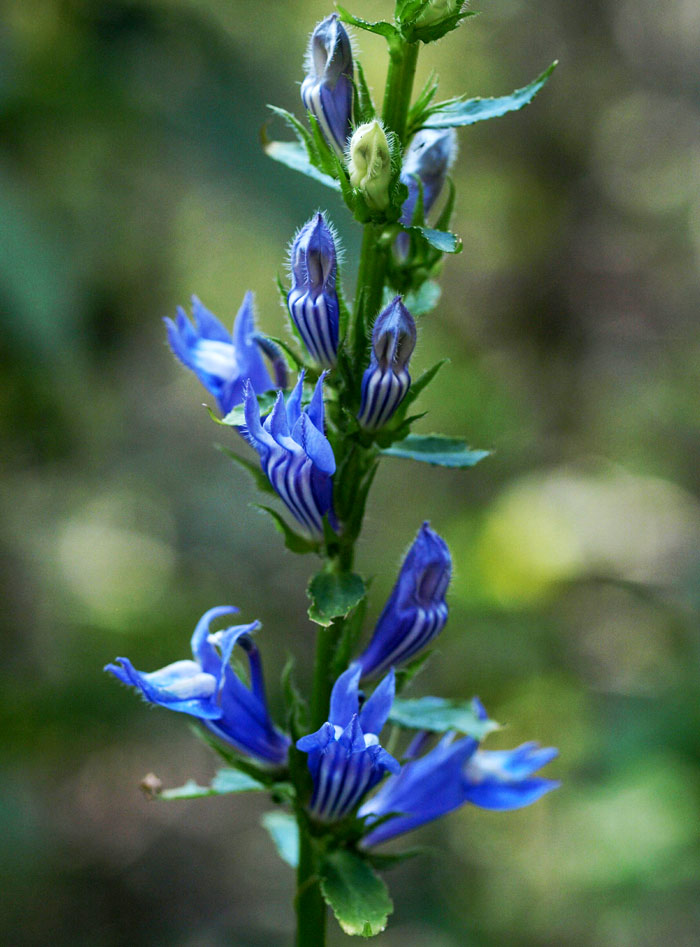
Lobelia siphilitica
Bellflower Family
Closely related to Cardinal Flower. According to Robert Henn [see Acknow–ledgements‚ below]‚ Native Americans thought this plant cured syphillis‚ hence the Latin species name. It doesn’t. Great Lobelia grows in wet places‚ as do Cardinal Flowers. At Lake Katharine‚ in one spot the Great Lobelia grows in a ditch on one side of the road‚ and Cardinal Flowers grow in a wet ditch on the other side of the road. These flowers cannot self–pollinate‚ and so need bumblebees in particular to gather nectar and pollen from the tubular blossoms.
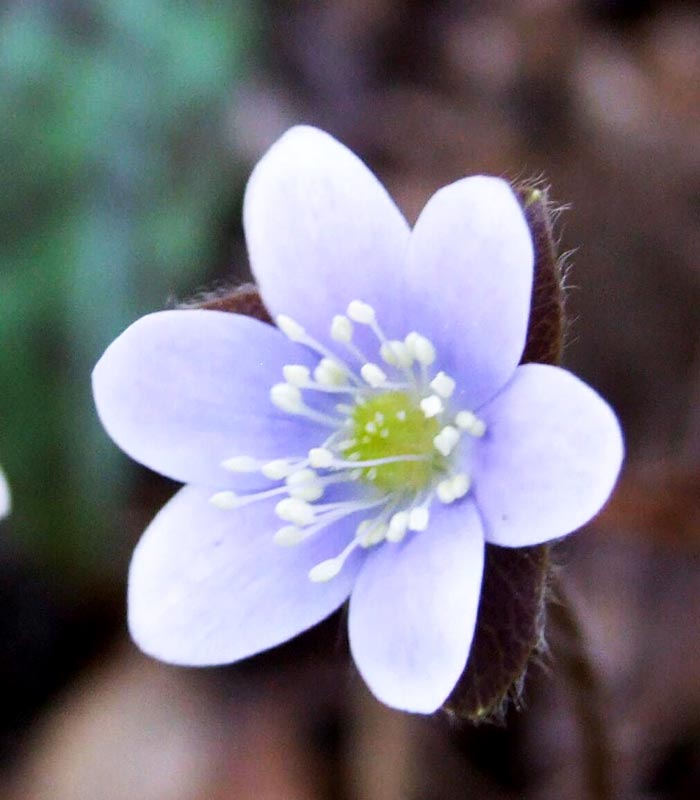
Hepatica nobilis
Buttercup Family
Leaves of Hepatica were once used to treat liver ailments‚ on the theory that the leaves looked liver–shaped. Hepatica‚ along with Bloodroot‚ are among the earliest spring wildflowers in the forest. Botanists are uncertain whether this flower should be classified in the genus Anenome instead of Hepatica. Nowadays genetic analysis brings about many changes in plant classification. Scientists can compare the actual DNA of different species of plants to gauge how closely they are related. The openly designed blossom of Hepatica allows access to many different potential cross–pollinators‚ but one wonders how many insects are out and about in the earliest spring when Hepatica blooms. The flower is capable of self–pollination‚ but more seeds are produced after cross–pollination. As with many wildfowers at Lake Katharine‚ Hepatica seeds have associated food bodies‚ or elaiosomes. Ants carry seeds back to their nests‚ eat the elaiosomes‚ and discard the seeds.
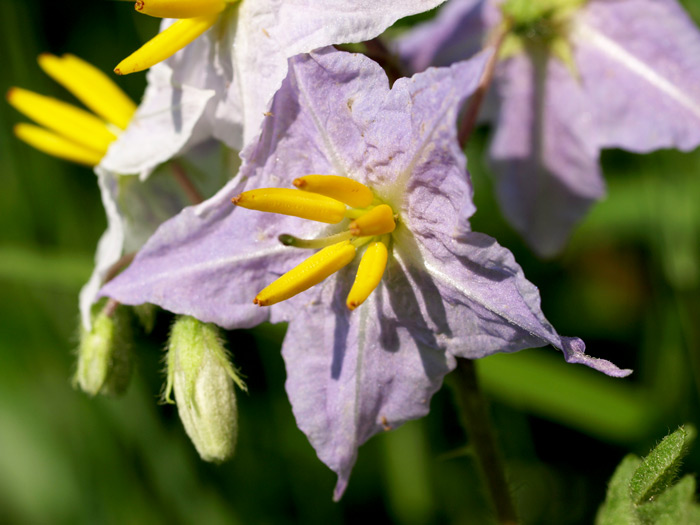
Solanum carolinense
Nightshade Family
This flower is related to potato‚ tomato‚ eggplant‚ red pepper‚ and tobacco. The banana-shaped structures in the flower are stamens‚ or pollen–producing reproductive organs. This plant is poisonous to humans due to a chemical called solanine. Also‚ it propagates vegetatively by rhizome‚ and so is hard to eradicate. That makes it a pest so far as people are concerned. Evolutionarily successful‚ but a pest.
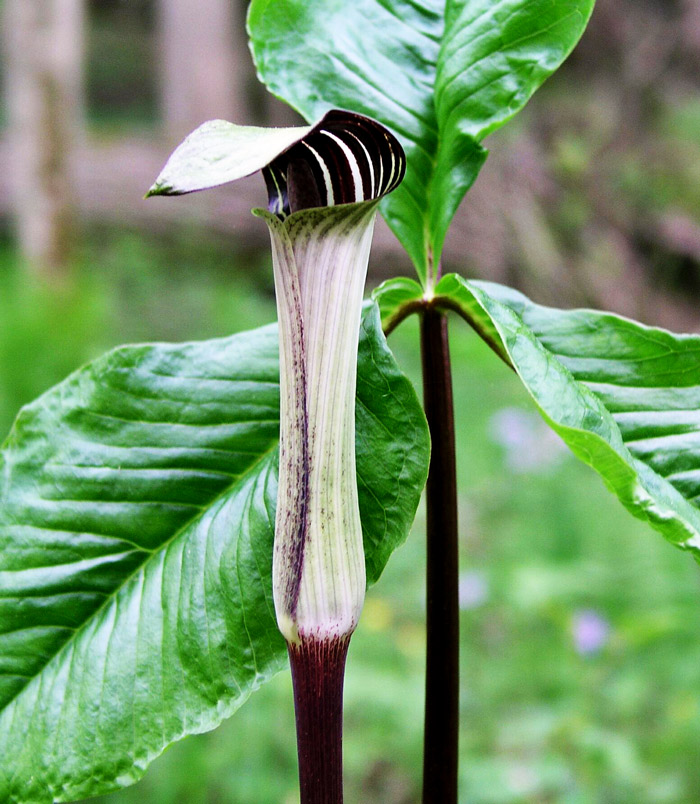
Arisaema triphyllum
Arum Family
Also Indian Turnip. The spadix is “Jack”‚ and the spathe is the “Pulpit”. The spadix is a columnar cluster of small flowers‚ with a vertical extension‚ while the spathe is a modified leaf which overhangs the spadix. The entire plant looks green and so is difficult to find; you need to concentrate on looking for the pulpit amongst the leaf litter on the forest floor. The flowers are unisexual‚ with only male flowers on one plant and only female flowers on another plant. In male plants‚ pollen collects at the bottom of the spathe. Insects enter the spathe to collect pollen‚ but they cannot climb up the inner surface of the spathe. In male flowers a small opening is found near the bottom of the spathe‚ and pollen–bearing insects escape through the opening. The insects then visit a female Jack–in–the–Pulpit and pollinate the flower. Unfortunately the insects cannot climb out of the spathe and the female form of the flower has no opening‚ so the insects inside the female flower often die there.

Helianthus tuberosus
Aster Family
“Jerusalem” is a corruption of the Italian girasole‚ which means “turning to the sun”. Lewis and Clark are said to have eaten tubers of Jerusalem Artichoke‚ prepared by Sacagawea. These tubers were exported to Europe as foodstuffs until they were displaced by potatoes in the eighteenth century. The tubers are sweet because of fructose‚ which is sweeter than sucrose. Jerusalem Artichoke tubers can be found for sale on the internet; try Googling “Jerusalem Artichoke”.
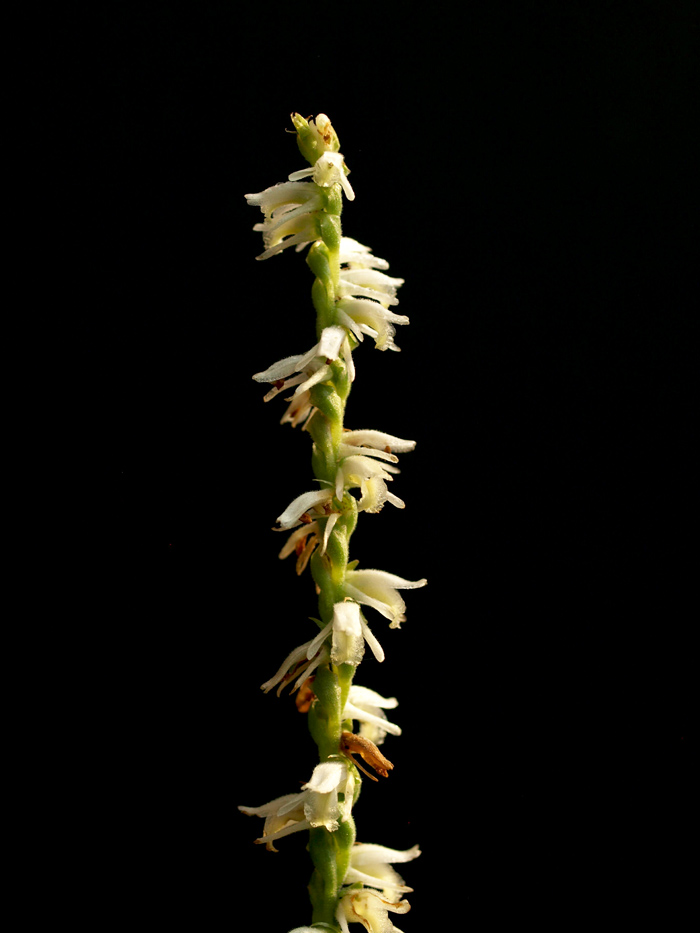
Spiranthes lacera
Orchid Family
Also Slender Ladies’ Tresses or Cemetery Orchids. The ascending spiral design is distinctive and unusual. These orchids are found beginning in early autumn near margins between field and forest‚ but they are not common in Jackson County. The genus name Spiranthes means “spiral flower”. Actually‚ the flowers are aligned on one side of the stem‚ and it is the stem which twists. That twisting is visible in the photograph here. Charles Darwin noticed that visiting bees start at the flower nearest the bottom of plant and work their way up the stem. The plant has evolved so that the flowers mature over time from the lower blossoms to the upper blossoms. The lower‚ more mature blossoms can receive pollen while the upper‚ less mature blossoms can only give pollen. One supposes that the lower blossoms would contain more nectar than the upper ones. In any event the bee starts at the bottom of the spike and works upward to the top‚ and then flies to the bottom of another plant. Cross–pollination again.
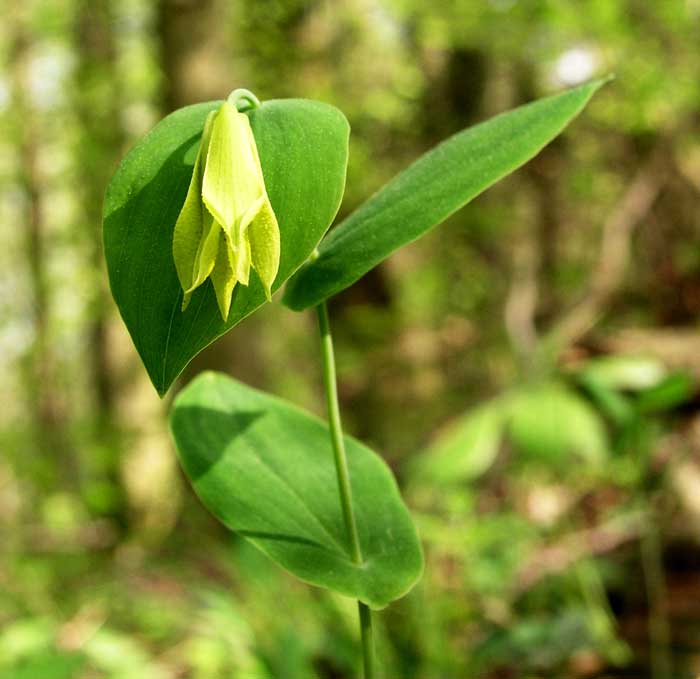
Uvularia grandiflora
Lily Family
This flower is found in shady woods. The yellow flower droops against the leaf. Its leaves appear to be pierced by the stem (that is‚ are perfoliate). The family grouping is confused in the reference books. Large–flowered Bellwort may have been reassigned to the family Colchicaceae within the order Liliales. Biologists are continually parsing out taxonomy according to the plant’s genome‚ and that is all quite beyond the rank amateur.
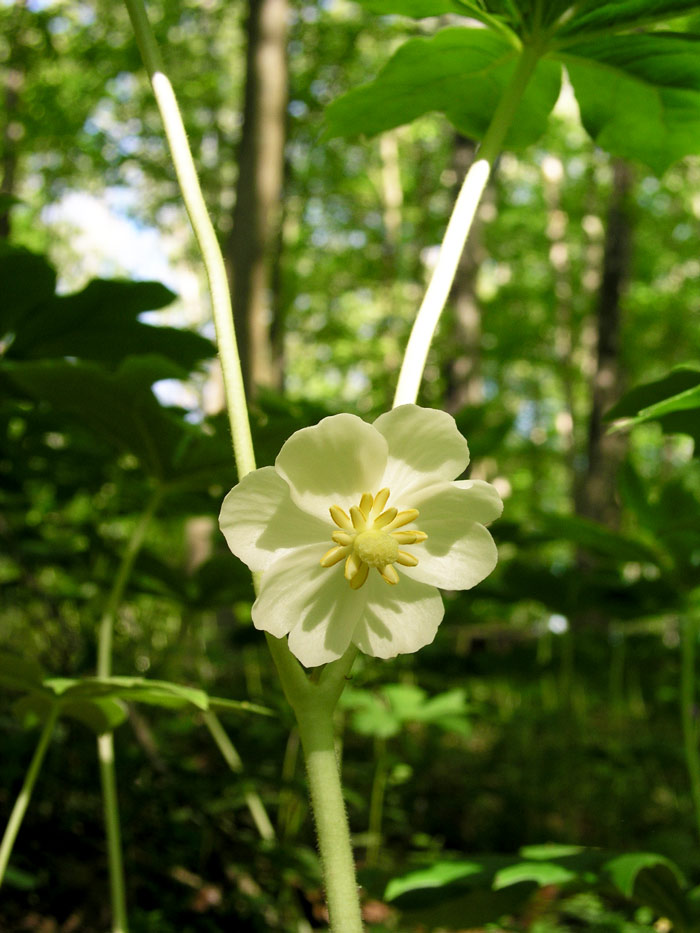
Podophyllum peltatum
Barberry Family
Also Mandrake. The good ship Mayflower was named after English Mayflower‚ or hawthorn‚ which is not our Mayapple. Mayapples grow from a branching network of underground rhizomes‚ so that what look like individual plants are actually interconnected clones. That is why you find Mayapples in the woods in rather dense clusters. Each clone has either one leaf or two leaves. Only plants with two leaves produce flowers. Mayapple flowers usually cannot be successfully fertilized with their own pollen‚ and cross–pollination requires the pollinating insect (usually a bumblebee) to visit different colonies of plants. Hence relatively few flowers produce fruit. The fruit that is produced looks like a yellow egg–shaped berry two inches in diameter. The fruit is edible‚ and is said to be quite tasty. The fruit often weighs down the plant so that a box turtle can reach it. Apparently box turtles love these Mayapple fruits and disperse seeds through the gut as far away as the turtle wanders after a meal. Other parts of the Mayapple‚ as well as unripe fruit‚ are toxic until late summer. According to Carol Gracie [see Acknowledgements‚ below], a chemical from Mayapple is used to produce cancer–treating medicines.

Symphyotrichum novae–angliae
Aster Family
The species name means New England‚ naturally. The family name Aster refers to the star shape of the blossom‚ with a center and rays. New England Asters have a composite center‚ or radiate head‚ made of disc flowers‚ surrounded by numerous ray flowers. The former name for the Aster family was the Composite family‚ meaning that what looks like one flower is actually composed of numerous flowers‚ or inflorescence‚ organized in the aster or daisy pattern.
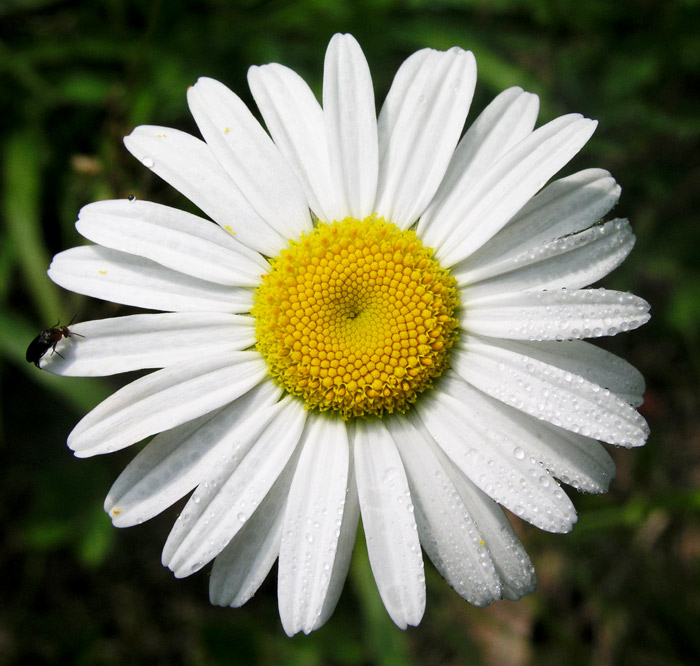
Leucanthemum vulgare
Aster Family
Also Marguerite Daisy. When the little girl was plucking petals from a daisy in the Lyndon Johnson campaign ad against Barry Goldwater‚ was that an Ox–eye Daisy? This daisy was introduced from Europe‚ and is considered by many an invasive species‚ or weed. The plant can be difficult to eradicate because it propogates from spreading rhizomes. The photograph shows the pseudanthium (“false flower”)‚ or multiple flower form‚ typical of the Aster family.
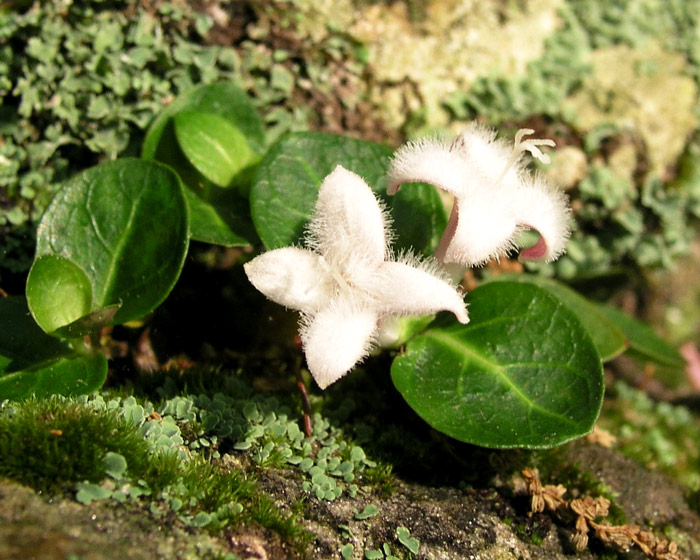
Mitchella repens
Madder Family
This is a ground creeper‚ or horizontal vine. The stems take root where contact is made with the soil‚ and produce leaves and flowers. The result is a mat–like appearance with attractive white–lined leaves. The leaves remain through the winter. The fruit is a tasteless bright red berry which many animals eat. This genus contains only two species‚ and the other species is found in Japan. One wonders how the two species can be so closely related yet so geographically separated.
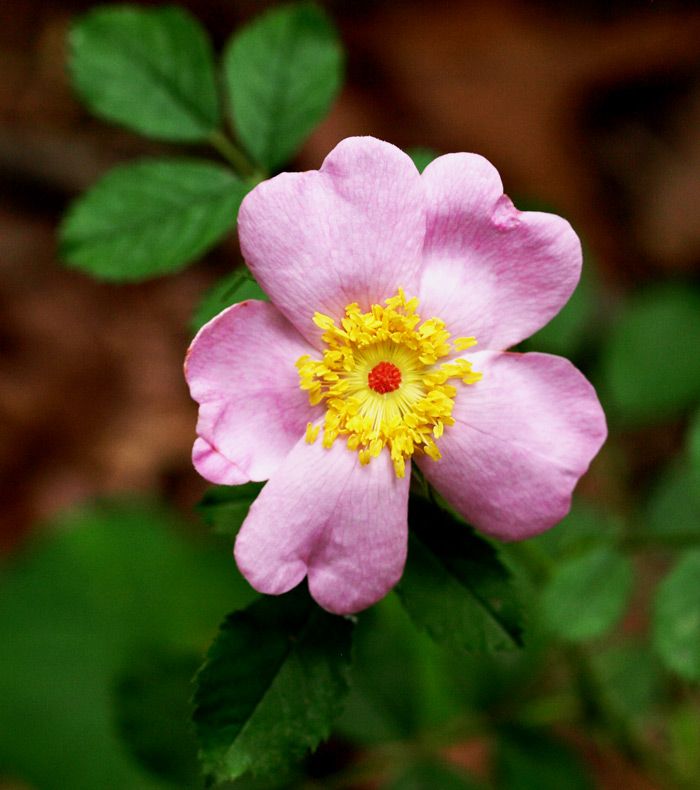
Rosa carolina
Rose Family
Also Wild Rose or Carolina Rose. The Rose family contains more than two thousand species. This particular rose is found more in open areas than in shaded woods. The flower produces edible rose hips. The Pasture Rose produces no nectar‚ so the bumblebees which typically visit the blossom are looking for pollen.
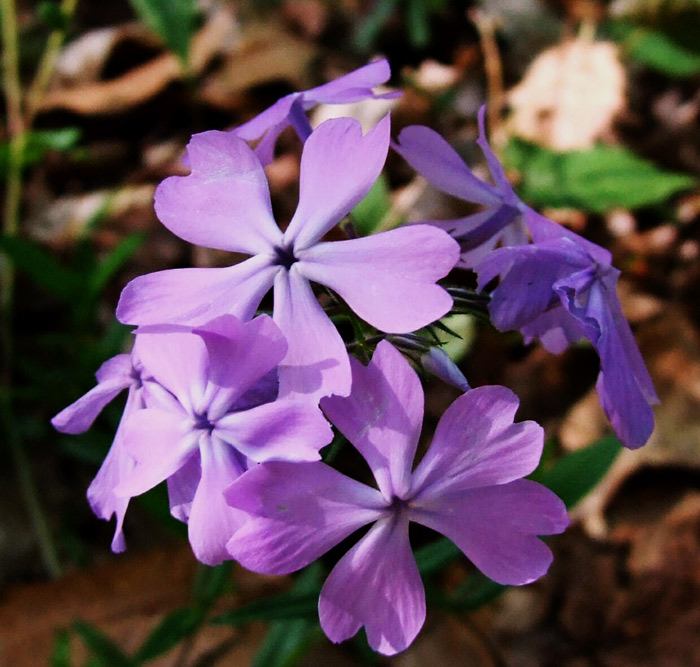
Phlox divaricata
Phlox Family
Also Blue Phlox or Wild Sweet William. These fragrant flowers are found in rich woods‚ and are very common at Lake Katharine. The five petals fuse to form a tube. The loose cluster of blossoms atop a stem is called a raceme. The plant spreads by horizontal stems producing roots and vertical stems at periodic nodes. The species epithet divaricata means “with a spreading and straggling habit.”
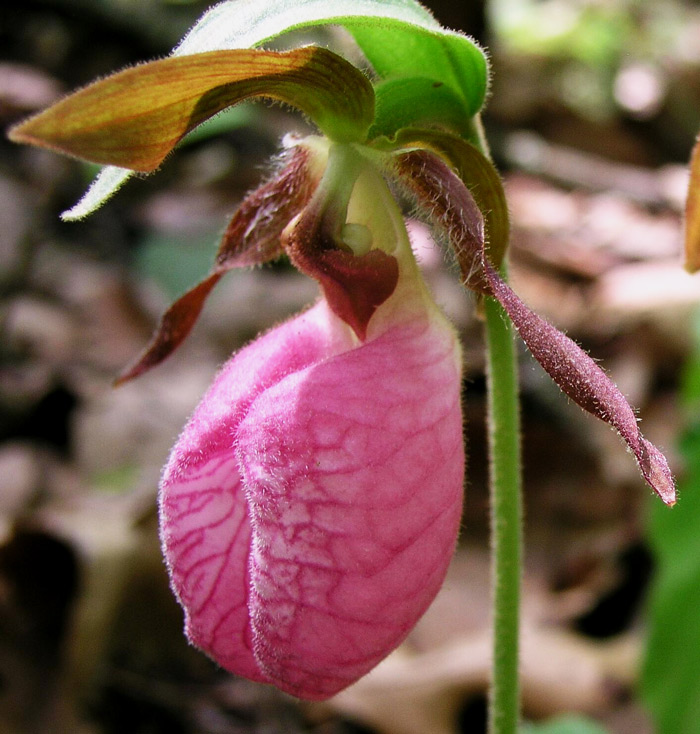
Cypripedium acaule
Orchid Family
Also Pink Moccasin Flower. This flower will not survive transplanting‚ so do not even think about it. Pink Ladyslipper has a symbiotic relationship with a subsurface fungus which provides nutrients to supplement the plant’s roots and leaves. If transplanted away from the fungus‚ the flower will eventually die. The Pink Ladyslipper is an orchid‚ and so produces an array of chemical defenses to deter herbivorous insects. These flowers produce no nectar‚ but they have a slit along the front of the blossom‚ inviting pollinators to enter. It takes a large insect such as a bumblebee to get past the gateway. The internal anatomy of the flower compels the insect to brush against a sticky stigma on the way out. If there is any pollen on the insect from an earlier visit to a different Pink Ladyslipper‚ then cross–pollination may occur. The flower produces thousands of dustlike seeds. To germinate and thrive‚ a seed must land in a place where the symbiotic fungus is found. Hence lots of seeds. In the woods of the eastern United States‚ deer eat lots of wildflowers‚ including the Pink Ladyslipper orchid. Wildflower enthusiasts tend to appreciate deer season.
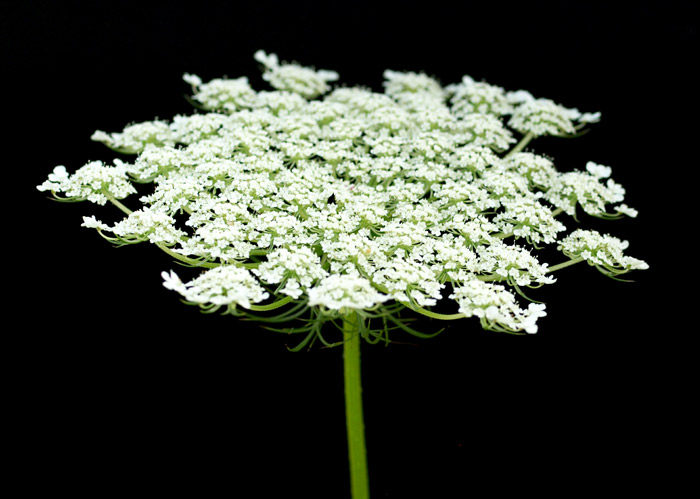
Daucus carota
Parsley Family
Also Wild Carrot. Queen Anne of England may have decorated her hair with these flowers. The umbrella–shape of the flower is called an umbel. Numerous short blossom stalks radiate from a common point‚ resulting in a disc–like display of potentially hundreds of florets. Cultivated carrots are a variety of the wild carrot species. The root of the wild carrot‚ while edible‚ is said to be much less tasty than the fleshier cultivated root. Jack Sanders [see Acknowledgements‚ below] pointed out that rural folks used to cut the flowers with lots of stem remaining and placed the stems in dyed water. The dye will migrate to the umbel to color the florets. Imagine what a bouquet one could assemble with several differently colored vegetable dyes.
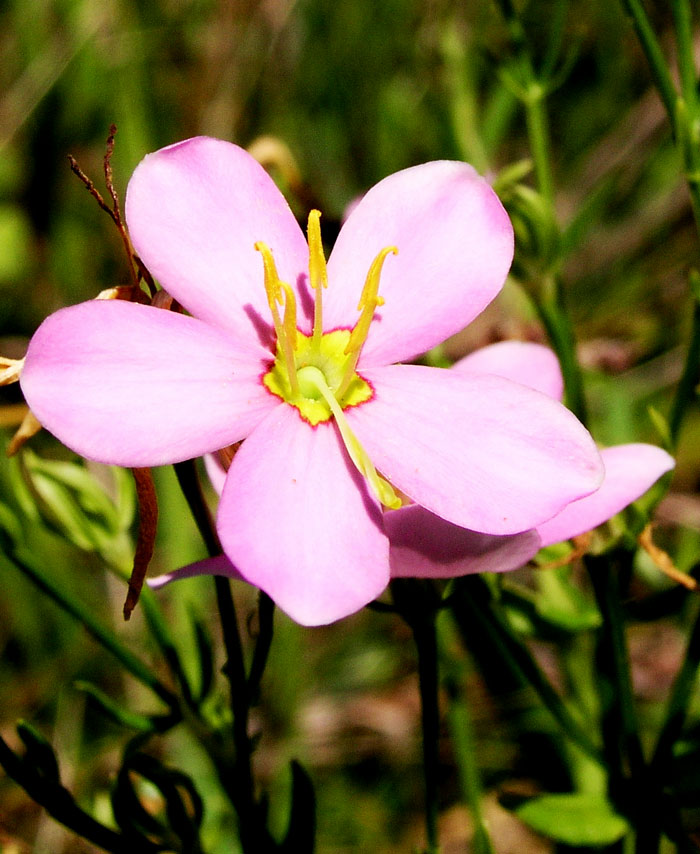
Sabatia angularis
Gentian Family
Also Rose Gentian and Bitterbloom. Rose Pink has a four–sided stem‚ hence the species epithet angularis‚ meaning “having sides”. This fragrant flower prefers sunny areas‚ not deep woods. Rose Pinks have been used to make a bitter tonic for indigestion.
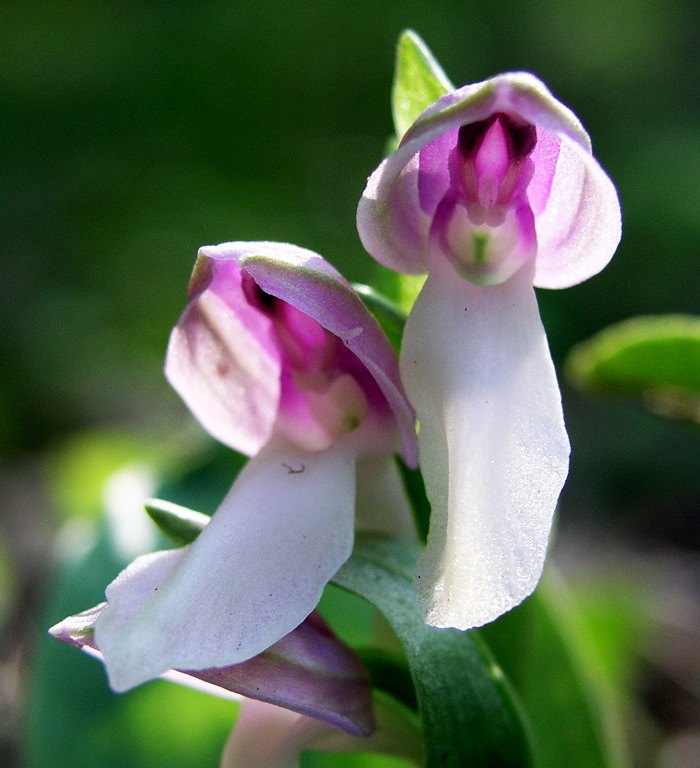
Galearis spectabilis
Orchid Family
The hood is formed from sepals and lateral petals. The Showy Orchis can propagate from a rhizome‚ and so can feature many blossoms in one site‚ which would then be clones. Nectar collects at the base of the spur‚ so the flower is popular with bumblebees and other long–tongued pollinators. Orchids do not transplant well. Showy Orchis is found in shady‚ rich moist woods‚ such as at Lake Katharine State Nature Preserve.
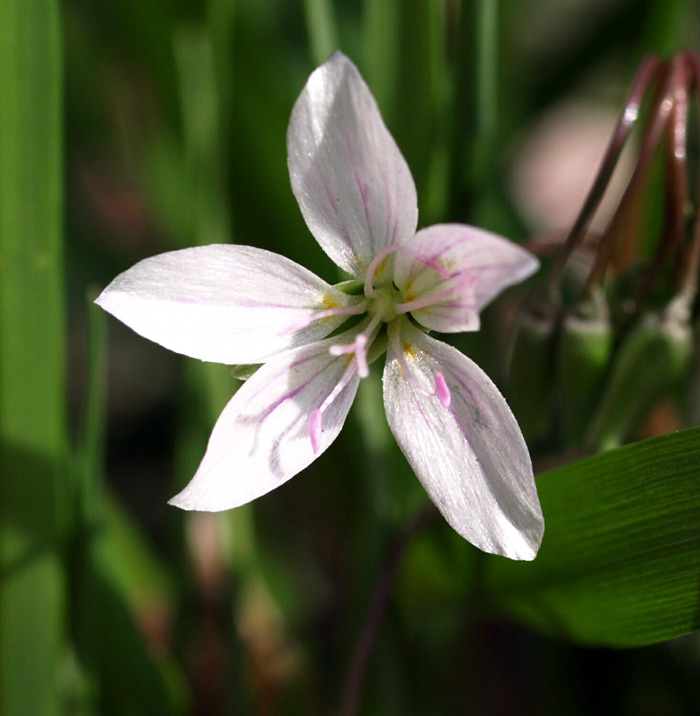
Claytonia virginica
Purslane Family
Very abundant in early spring at Lake Katharine. The tiny blossoms are pinkish to whitish‚ depending upon various factors in the flower’s microniche. Many wildflowers come out in the early spring before the trees leaf out. Obviously this allows the Spring Beauty’s leaves to catch sunlight to photosynthesize and build up starch in its tuber. The flowers open when the temperature exceeds 52°. The bees which visit the flower most frequently become active at about 55°‚ so the bees mesh pretty well with the flowers. The pink lines in the petals and the yellow spots at the base of the petals help guide the insects to the nectar and pollen.
On the first day the flower is open the anthers release pollen. On the second day the stamens bend away from the style‚ and the style splits into three stigma surfaces. Thus the flower transitions from its male phase to its female phase. That has happened in the photograph here. The Spring Beauty closes its blossoms at night‚ when there are no pollinators around‚ and during rain‚ when the nectar could become diluted by rainwater. As with several other spring wildflowers‚ ants disperse the Spring Beauty seeds by myrmecochory. See Dutchman’s Breeches‚ above. The starchy underground tubers are supposed to be edible‚ but small.
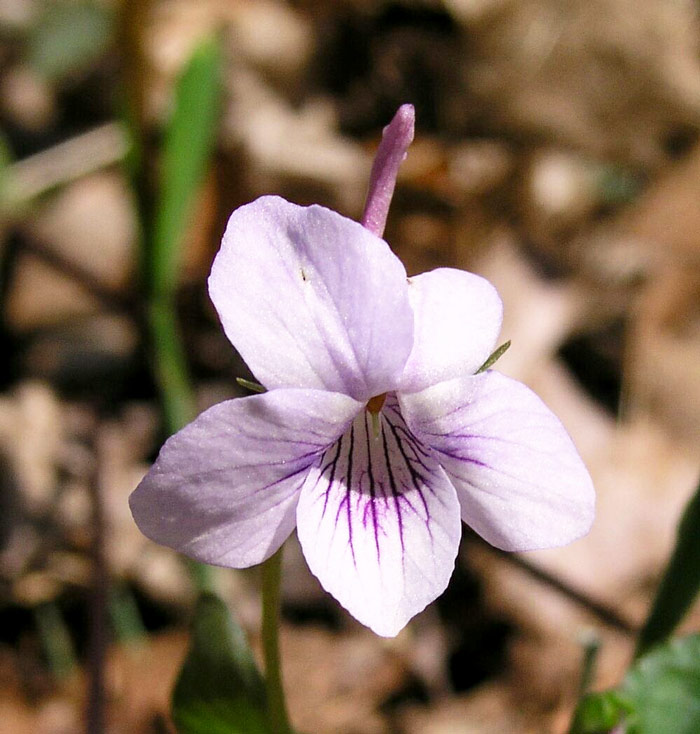
Viola rostrata
Violet Family
Also Long–spurred Violet. Note the conspicuous upright nectar spur at the rear of the flower. The flowers are often a light blue with a dark center. Carol Gracie in Spring Wildflowers of the Northeast points out that a syrup for cooking is made from violets. Also‚ violet blossoms are sometimes simply tossed into a salad. The French at Toulouse make a confection called crystalized violets‚ apparently to decorate cakes.
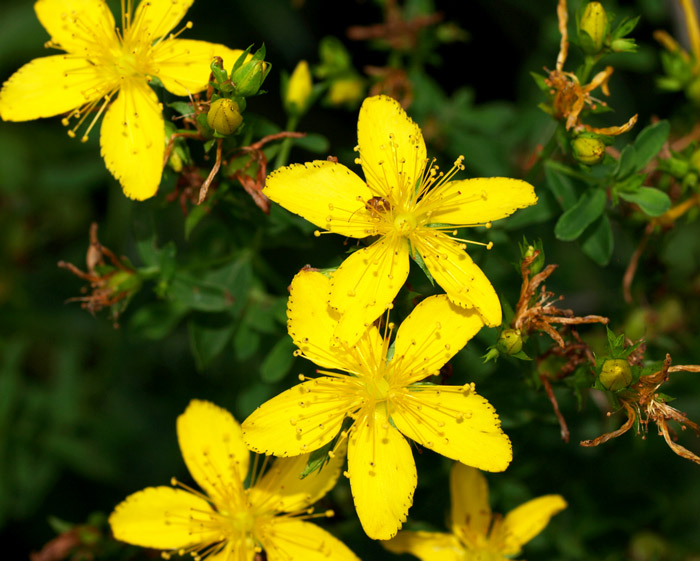
Hypericum perforatum
St. John’s–wort Family
Also Common St. John’s–wort. This flower is commonly used as an antidepressant‚ and an extract is sold in natural food stores. The active ingredient is hypericin. Some studies have apparently found St. John’s–wort effective in elevating mood‚ but not necessarily in treating depresson. According to Jack Sanders [see Acknowlegements‚ below]‚ at the turn of the twenty–first century‚ St.John’s–wort outsold Prozac eight to one in Germany. Also‚ the petals turn red when crushed. This may be the association with St. John the Baptist‚ who was bloodily beheaded.
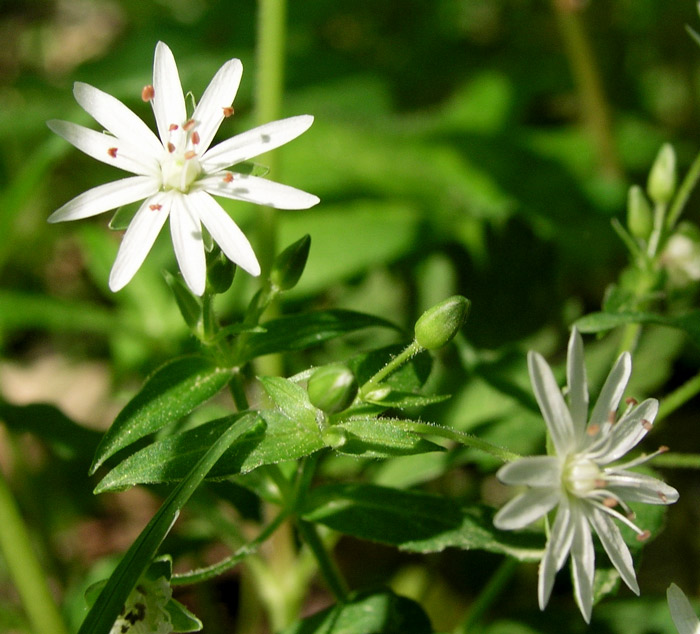
Stellaria pubera
Pink Family
Star Chickweed is an Ohio native‚ distinguished by the dark anthers. Note that the five petals are so deeply cleft that they look like ten. Notched petals are characteristic of the Pink family. See‚ for example‚ Fire Pink‚ above. Chickweeds have the genus name Stellaria‚ referring to their star shape. The species epithet pubera means “hairy”‚ because the stems have rows of hairs running up and down. These hairs may assist in channelling water‚ as from dew‚ down to the lower parts of the flower which need moisture. This is thought to be a rather advanced evolutionary adaptation to assist hardiness in dry weather. Wild birds eat chickweed seeds‚ and humans eat chickweed leaves.
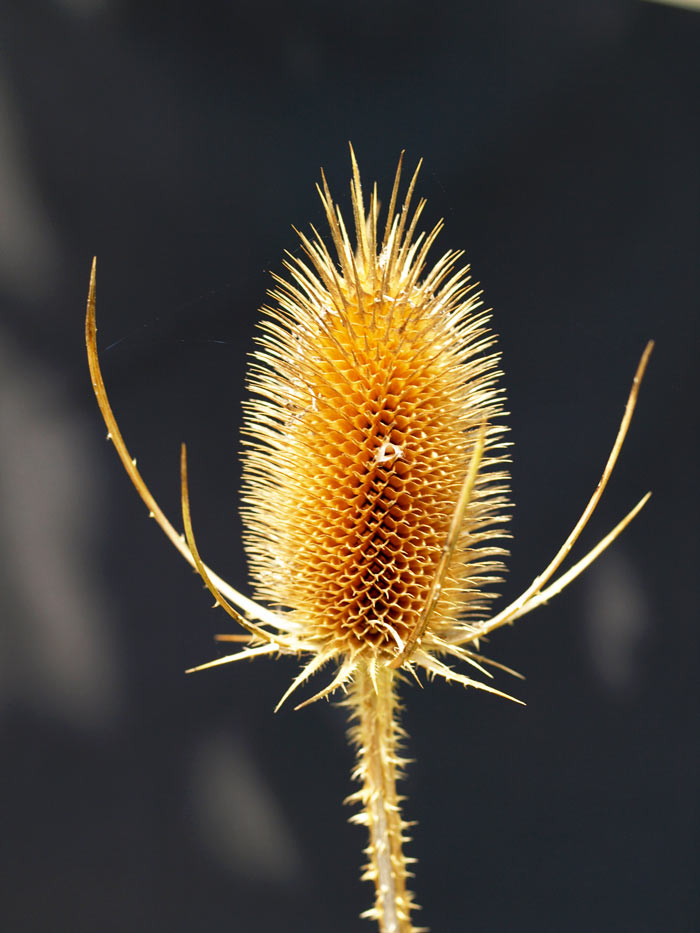
Dipsacus fullonum
Teasel Family
Also Common Teasel or Fuller’s Teasel. This flower is not a thistle‚ though it looks like one. Dried teasel heads‚ like the one shown in the photograph‚ are often used in ornamental flower arrangements. Teasel is an invasive species which can outcompete other more desirable plants. At least the seeds in the flower head supply provender for nearby birds‚ including goldfinches.
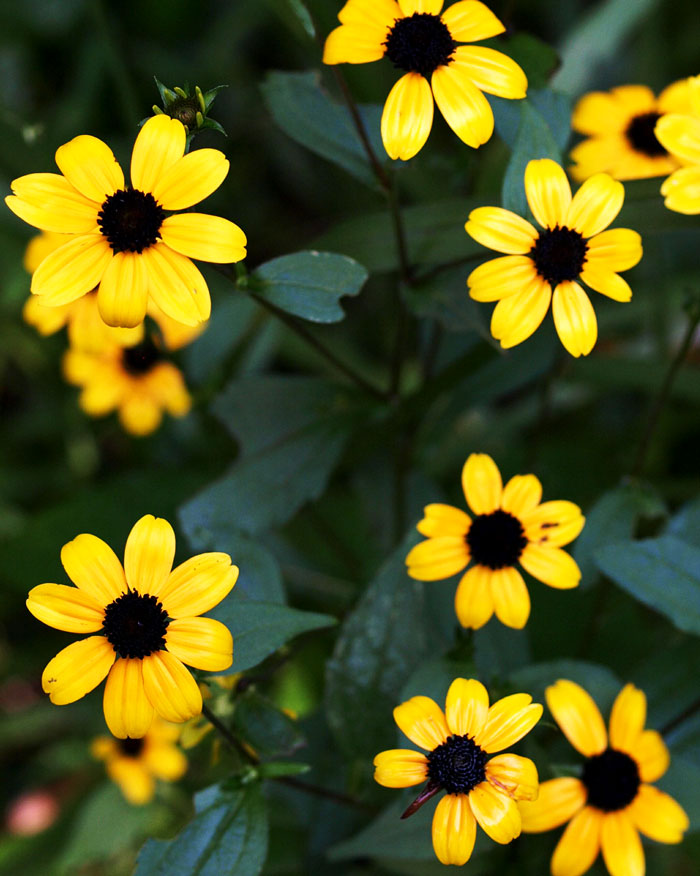
Rudbeckia triloba
Aster Family
Also Three–lobed Coneflower and Brown–eyed Susan. Coneflower petals appear to droop. This species has what look like nicks at the tips of the petals. The genus of coneflowers‚ Rudbeckia‚ is named after Olaus Rudbeck Sr. and Jr.‚ who were both botany professors at the University of Upsala in Sweden. Professor Rudbeck‚ Jr. was the mentor during the early eighteenth century of the great Swedish taxonomist Carl Linnaeus.
Coneflowers are members of the Aster Family. The blossoms feature composite disc flowers and ray flowers on one head. Thin–leaved Coneflowers bloom for up to three months during the summer‚ in sunny habitats.
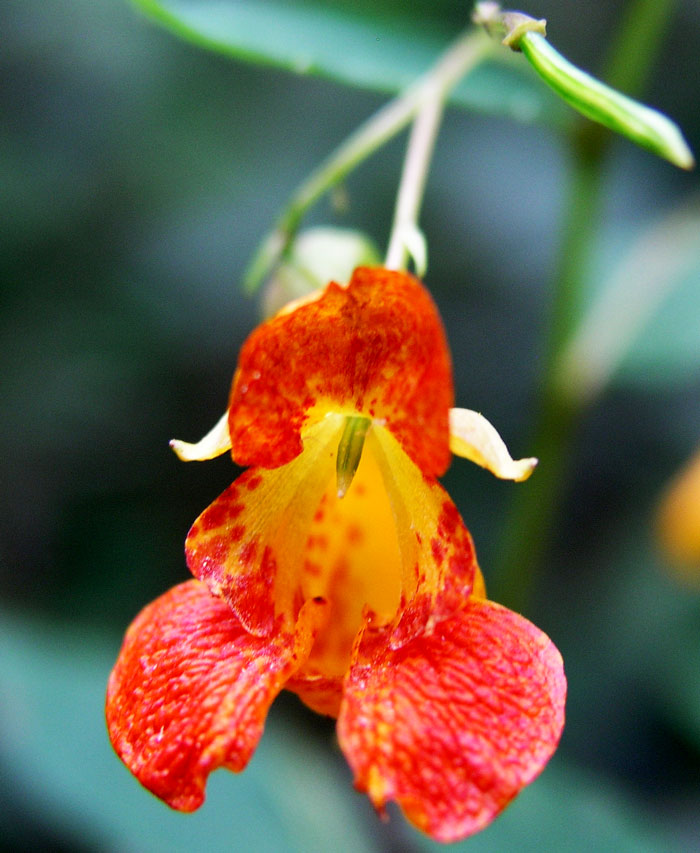
Impatiens capensis
Touch–me–Not Family
Also Spotted–Touch–me–not or Orange Jewelweed. According to Henn’s Wild Flowers of Ohio‚ when applied to the skin‚ juice from the stem of this plant will relieve the burning sensation received from the Stinging Nettle. Jack Sanders in The Secrets of Wildflowers endorses Touch–me–not also to treat poison ivy. He maintains that the sap can dissolve the irritating poison ivy oil before it can adhere long enough to cause blistering.
Evolution has shaped the blossom of Touch–me–not for cross–pollination by Ruby–throated Hummingbirds. When the bird inserts its bill into the blossom for nectar‚ it brushes against pollen situated in just the right place inside the flower. The bird then deposits the pollen into the next blossom in just the right place to achieve pollination. Bumblebees do not achieve the same result because they cannot reach the nectar. White–tailed Deer‚ however‚ behave differently. They voraciously eat the entire plant.
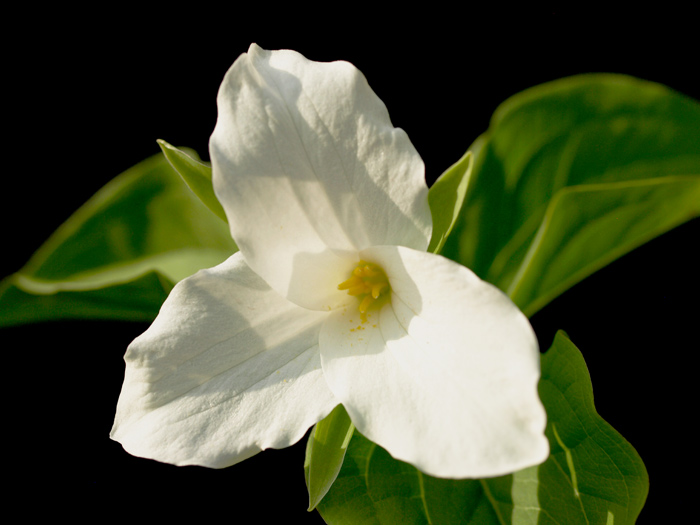
Trillium grandiflorum
Bunch–flower Family
Also Large–flowered Trillium. This Trillium in the past grew profusely enough to cover hillsides in the forest at Lake Katharine‚ until the deer population burgeoned. Now we find it in places the deer cannot reach. Trillium grows from a subsurface rhizome. The plant will not produce blooms until there is a sufficient quantity of nutrients in the rhizome. So first to appear are just leaves to photosynthsize starch for the rhizome. The rhizome shows a distinctive groove or stricture for each season’s stem. Botanists can count the strictures like tree rings in a trunk cross–section. According to Carol Gracie [see Acknowledgements‚ below]‚ a Trillium plant can reach seventy years old. The species in the photograph‚ T. grandiflorum‚ may take sixteen or seventeen years before the rhizome produces a blooming flower.
Trillium seeds contain elaiosomes‚ which are tasty and nutricious bits attached to the outside of the seeds. Ants‚ daddy–longlegs‚ and some wasps carry the seeds away from the original plant‚ and eat the elaiosomes and discard the rest of the seed. The seeds end up in the ground well away from the original plant‚ and seed dispersal has been neatly accomplished. Carol Gracie explains the role of oleic acid in this process. The elaiosome contains this fatty acid‚ oleic acid. This same chemical is produced when ants die and start to decompose. Oleic acid triggers a behavior in ants to carry the dead ants outside the nest. This carrying behavior is also triggered by the oleic acid in the seed elaisome. That is‚ the ant carries the seed away. It turns out that daddy–longlegs and the wasps feed on dead ant bodies‚ and are probably attracted to the Trillium seed by the odor of the oleic acid. Trillium seeds literally smell like dead ants‚ and that is how the seeds get dispersed.
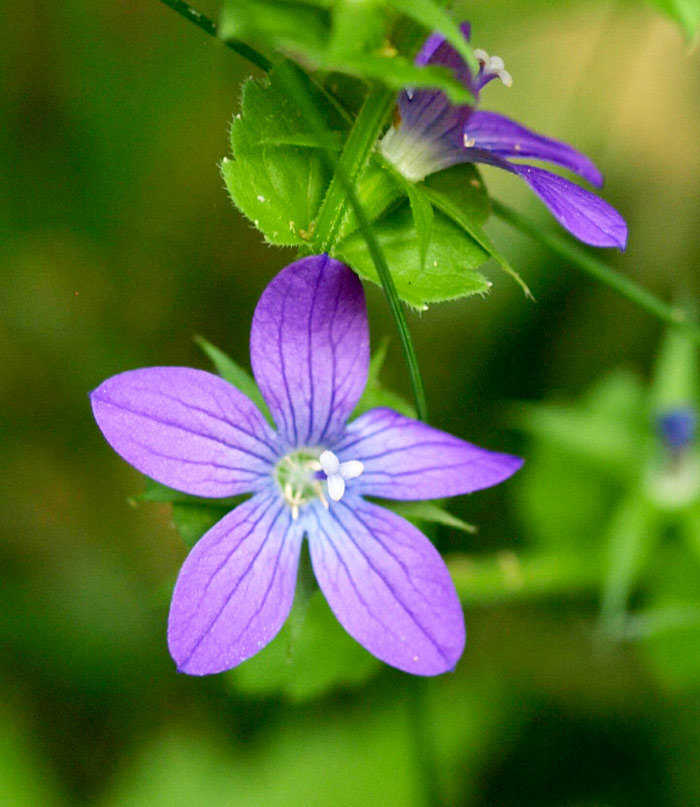
Triodanis perfoliata
Bellflower Family
The species name is perfoliata. A perfoliate leaf looks like the stem is piercing the leaf. Here the blossom appears to grow upward from the leaf. See also Large-Flowered Bellwort for a perfoliate leaf.
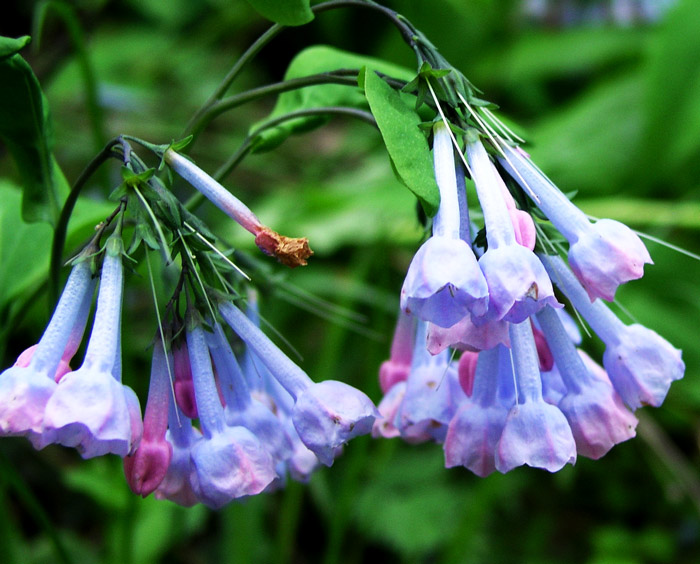
Mertensia virginica
Borage Family
Also Virginia Cowslip. In the spring at Lake Katharine on the Salt Creek Trail at the creek level‚ Virginia Bluebells cover hundreds of square feet of ground. They all disappear completely later on‚ so this flower is called a spring ephemeral. The blossoms of Virginia Bluebells change color as they mature‚ from small pink buds to pinkish–purple‚ to blue. The color changes are caused by changes in the acidity of the cell sap within the plant. The blossom features a long tube with nectar at the base. Bumblebees are the primary pollinators. In the process of collecting nectar and pollen from various blossoms‚ they also distribute pollen. Some shorter–tongued insects pierce the tube to get at the nectar. Since the pollen is quite near the nectar‚ they also cross–pollinate as they feed on several blossoms. Virginia Bluebells and Dutchman's Breeches are the most important early–spring food sources for bumblebees.
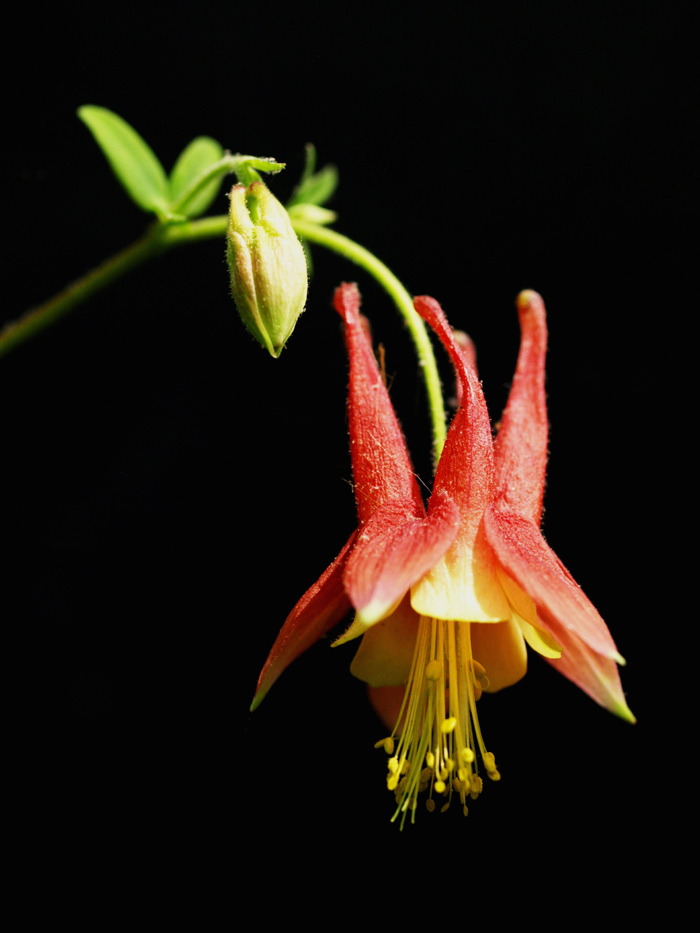
Aquilegia canadensis
Buttercup Family
The spurs of Wild Columbine are thought to resemble talons‚ hence the genus name Aquilegia. At least that is one theory for the name. The red spurs of the Wild Columbine attract Ruby–throated Hummingbirds to the flower’s nectar. The flower stalks are so delicate that the hummingbird must hover below the blossom while it feeds on the nectar. The first appearance of Columbine flowers in May coincides with the arrival of Ruby–throated Hummingbirds from their annual migration. The nectar is found in the tip of the spur. The length of the spurs excludes access to nectar for all visitors other than hummingbirds and some long–tongued bees. A hummingbird will visit several flowers to get enough nectar for sustenance‚ and in the process may cross–pollinate the flowers. The flowers also self–pollinate‚ however‚ so they do not absolutely depend upon the hummingbirds.
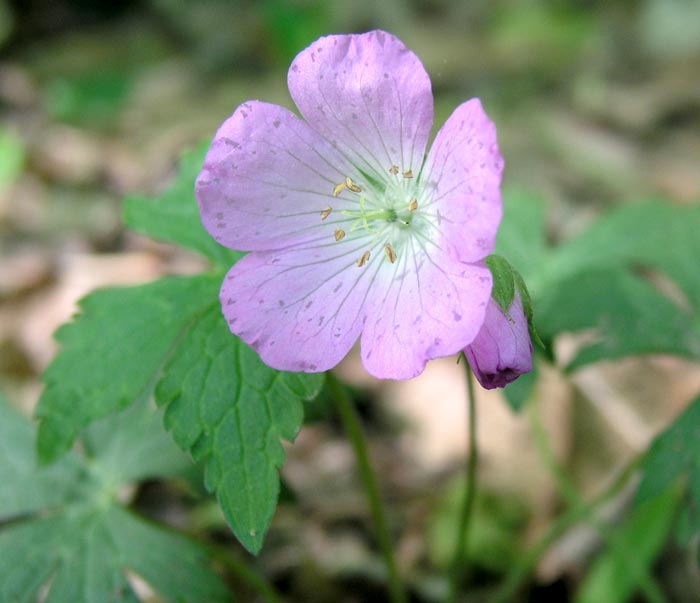
Geranium maculatum
Geranium Family
Also Crane’s Bill. A distant relative to household geranium. The seeds of Wild Geranium are packed into a long pod. As the pod dries out it becomes tense‚ so that when the pod dehisces the seeds pop out. The seeds may fire out as much as thirty feet‚ thereby achieving wide dispersal. Then each individual seed has an awn‚ or tail. This awn curls when dry and straightens when wet. This curling and uncurling imparts tail–twisting motion to the seed‚ which can propel it slowly along the ground until it encounters a hole or crack. Thus the seed can find a spot to germinate away from animal predators. Another unusual aspect of Wild Geranium is the color of its pollen‚ which is blue.
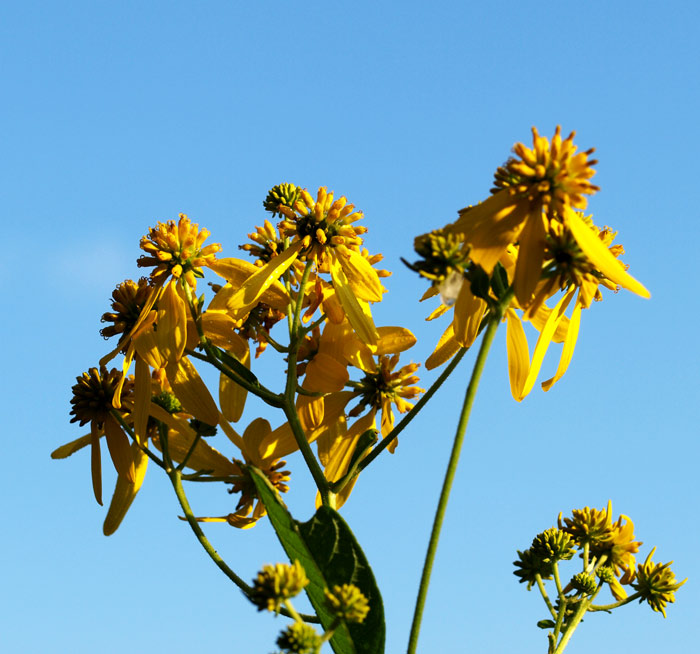
Verbesina alternifolia
Aster Family
The leaves are alternate (alternifolia), and feel sandpapery to the touch. The unbranched stem features distinctive “wings”. Wingstem blooms in the late summer‚ and can grow as tall as eight feet high. Being in the Aster Family‚ the blossoms are composite‚ with central disc flowers and radiating ray flowers. The ray flowers droop naturally‚ in a sort of haphazard way.
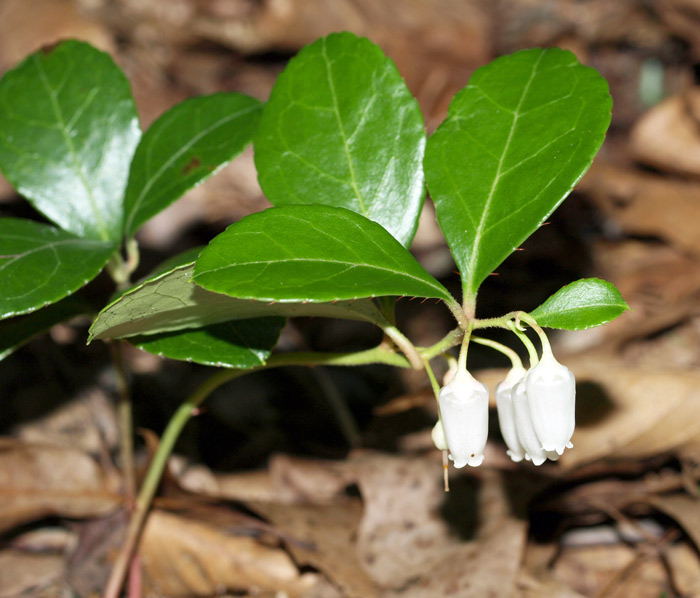
Gaultheria procumbens
Heath Family
Also Teaberry or Deerberry. This is the original source for wintergreen flavoring. The name “wintergreen” is also applied to Chimaphila maculata‚or Spotted Wintergreen‚ with striped evergreen leaves which lie flat upon the ground.
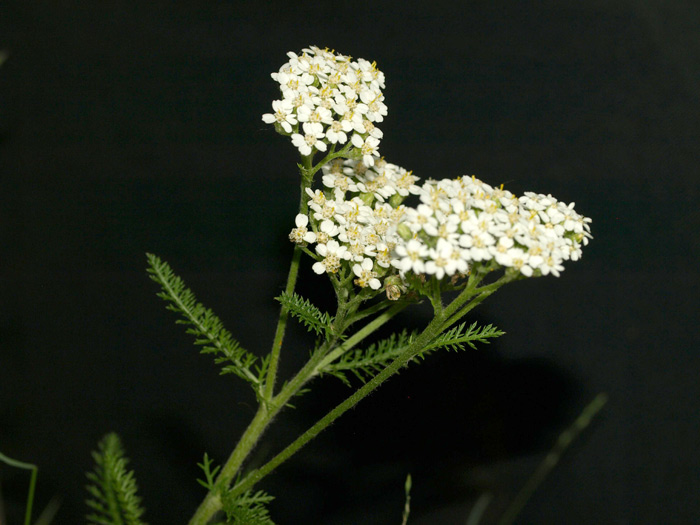
Achillea millefolium
Aster Family
The species name millefolium means “thousand leaves”‚ referring to the numerous leaflets in the leaves. The leaves are said to be “twice cut”‚ because the leaves subdivide into leaflets. The many composite flowers arrange themselves into umbrella–shaped umbels. Early folks used Yarrow tea to treat colds and ever‚ according to Henn’s Wild Flowers of Ohio.

Viola pubescens
Violet Family
Also Common Yellow Violet or Downy Yellow Violet. The species name pubescens refers in botany to a downy surface‚ here on the stems and leaves. The flower grows on a stem that originates in the axil of the leaf. Empress Josephine‚ Napoleon’s first wife‚ enjoyed violets. Napoleon always sent her a bouquet of sweet–smelling violets on their anniversary. Then he divorced her to marry Marie Louise in order to produce an heir. When Napoleon escaped back to France from Elba‚ he reputedly visited Josephine’s grave to pick violets to remember her by. Then he went to Waterloo.
Comments and Acknowledgements
I took these photographs with various digital cameras‚ in the field. On occasion I used portable hand–fashioned reflectors or backdrop. For identification and general information‚ my wife Aggie and I refer primarily to Wild Flowers of Ohio, Second Edition, by Robert L. Henn. We highly recommend that anyone with an interest in Ohio wildflowers purchase this book and take it with you into the field (or forest‚ as the case may be). Lake Katharine in the springtime would be a good place place to start. My expertise does not exceed that of an interested amateur hobbyist. I have also used other field guides including Newcomb’s Wildflower Guide by Lawrence Newcomb‚ Wildflowers in Color by Arthur Stupka‚ National Wildlife Federation’s Field Guide to Wildflowers of North America by David M. Brandenburg‚ and of course Google and Wikipedia. Fuller treatments may be found in Carol Gracie’s excellent Spring Wildflowers of the Northeast and The Secrets of Wildfowers by Jack Sanders. Aggie’s and my interest began many years ago with a wildflower walk at Lake Katharine conducted by Mr. Dick Mosely‚ then the Chief of Ohio’s Division of Natural Areas‚ and now retired. The State of Ohio has in recent years defunded the Division of Natural Areas‚ to the detriment of its citizens as well as to nature. ![]()

